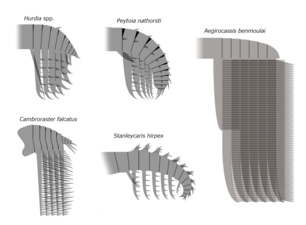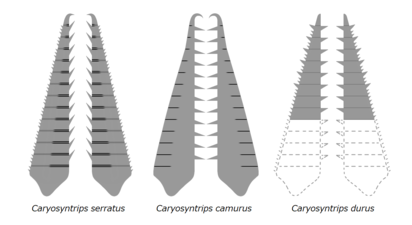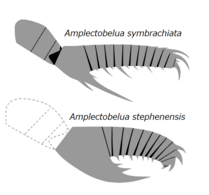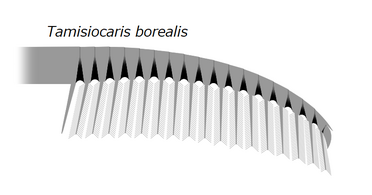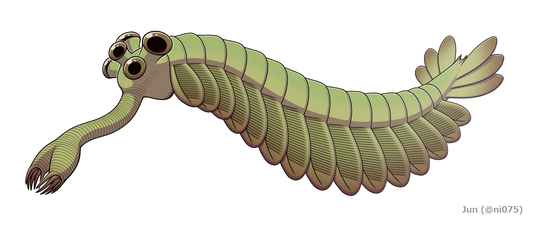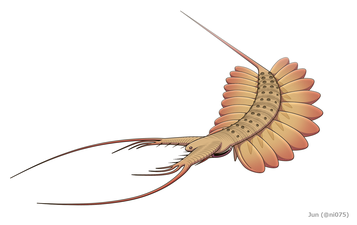「アノマロカリス類」の版間の差分
Zeng et al. 2017 と Wu et al. 2021|発見地の原記述 |
|||
| 37行目: | 37行目: | ||
* ''[[:en:Cordaticaris|Cordaticaris]]'' |
* ''[[:en:Cordaticaris|Cordaticaris]]'' |
||
* ''[[:en:Buccaspinea|Buccaspinea]]'' |
* ''[[:en:Buccaspinea|Buccaspinea]]'' |
||
* ''[[:en:Lenisicaris|Lenisicaris]]'' |
|||
<center>[[アノマロカリス類#下位分類|本文]]も参照 |
<center>[[アノマロカリス類#下位分類|本文]]も参照 |
||
}} |
}} |
||
| 195行目: | 196行目: | ||
長い間、カンブリア紀中期終盤(約5憶100万年前)より晩期の堆積層からアノマロカリス類の化石が発見されなかったため、本群の生息期間は[[カンブリア紀]]に限定され、そこで[[絶滅]]したと考えられていた。しかし2010年代以降では、[[オルドビス紀]]前期の[[エーギロカシス]]が発見された<ref name=":44">{{Cite journal|last=Van Roy|first=Peter|last2=Briggs|first2=Derek E. G.|date=2011-05|title=A giant Ordovician anomalocaridid|url=https://www.academia.edu/22959992/A_giant_Ordovician_anomalocaridid_Supplementary_Figures_|journal=Nature|volume=473|issue=7348|pages=510–513|language=En|doi=10.1038/nature09920|issn=0028-0836}}</ref><ref name=Roy/>ことと、[[デボン紀]]前期の[[シンダーハンネス]]<ref name=Kuhl2009/>がアノマロカリス類として認められることにより、本群はカンブリア紀を超えて生存していたことが判明し、生息期間の記録が数千万年も延長された。 |
長い間、カンブリア紀中期終盤(約5憶100万年前)より晩期の堆積層からアノマロカリス類の化石が発見されなかったため、本群の生息期間は[[カンブリア紀]]に限定され、そこで[[絶滅]]したと考えられていた。しかし2010年代以降では、[[オルドビス紀]]前期の[[エーギロカシス]]が発見された<ref name=":44">{{Cite journal|last=Van Roy|first=Peter|last2=Briggs|first2=Derek E. G.|date=2011-05|title=A giant Ordovician anomalocaridid|url=https://www.academia.edu/22959992/A_giant_Ordovician_anomalocaridid_Supplementary_Figures_|journal=Nature|volume=473|issue=7348|pages=510–513|language=En|doi=10.1038/nature09920|issn=0028-0836}}</ref><ref name=Roy/>ことと、[[デボン紀]]前期の[[シンダーハンネス]]<ref name=Kuhl2009/>がアノマロカリス類として認められることにより、本群はカンブリア紀を超えて生存していたことが判明し、生息期間の記録が数千万年も延長された。 |
||
アノマロカリス類が発見される堆積層は次の通り |
アノマロカリス類が発見される堆積層は次の通り<ref name=":2" /><ref name=":24" /><ref name=":34" /><ref name=":19" /><ref name=":21" />。 |
||
; [[カンブリア紀]][[カンブリア紀第三期|第三期]](約5億2100万 - 5億1400万年前) |
; [[カンブリア紀]][[カンブリア紀第三期|第三期]](約5億2100万 - 5億1400万年前) |
||
* [[:en:Zawiszany formation|Zawiszany formation]]([[ポーランド]]):''[[ラガニア#分類|Peytoia infercambriensis]]''<ref name=":33" /> |
* [[:en:Zawiszany formation|Zawiszany formation]]([[ポーランド]]):''[[ラガニア#分類|Peytoia infercambriensis]]''<ref name=":33" /> |
||
* [[:en:Maotianshan Shale|Maotianshan Shale]] |
* [[:en:Niutitang formation|Niutitang formation]]([[:en:Zunyi Biota|Zunyi Biota]]、[[中国]]、[[貴州省]]):[[アンプレクトベルア|''Amplectobelua symbrachiata'']]<ref name=":2" /> |
||
*[[:en:Maotianshan Shale|Maotianshan Shale]]([[澄江動物群]]、中国、[[雲南省]]):[[アンプレクトベルア|''Amplectobelua symbrachiata'']]<ref name="Hou1995" />、[[アノマロカリス|''Anomalocaris'' cf. ''canadensis'']]<ref name=":23" />、''[[アノマロカリス|Anomalocaris saron]]''<ref name="Hou1995" />、''[[カンブロラスター|Cambroraster]]'' [[カンブロラスター|cf. ''C. falcatus'']]<ref name=":39" />、[[ククメリクルス|''Cucumericrus decoratus'']]<ref name="Hou1995" />、[[ラミナカリス|''Laminacaris chimera'']]<ref name=":12" />、''Lenisicaris lupata''<ref name=":23" />、''[[ライララパクス|Lyrarapax trilobus]]''<ref name=":25" />、[[ライララパクス|''Lyrarapax unguispinus'']]<ref name="cong2014" />、''Ramskoeldia platyacantha''<ref name="Ramskoeldia" />''、Ramskoeldia consimilis''<ref name="Ramskoeldia" />、''Zhenghecaris shankouensis''<ref name=":2" /> |
|||
* [[ |
* [[:en:Buen formation|Buen formation]]([[シリウス・パセット動物群]]、[[グリーンランド]]):[[タミシオカリス|''Tamisiocaris borealis'']]<ref name=":17" /><ref name="Vinther2014" /> |
||
| ⚫ | * [[:en:Shuijingtuo Formation|Shuijingtuo Formation]](中国、[[湖北省]]):[[フルディア|''Hurdia'' indet. sp.]]<ref>CU I, Z. L. and HUO, S. C. 1990. [https://en.cnki.com.cn/Article_en/CJFDTOTAL-GSWX199003007.htm New discoveries of Lower Cambrian crustacean fossils from Western Hubei]. Acta Palaeontologica Sinica, 29, 321–330.</ref><ref name="Daley" /><ref name=":19" /> |
||
| ⚫ | |||
* [[:en:Shuijingtuo Formation|Shuijingtuo Formation]]([[:en:Qingjiang biota|Qingjiang biota]]、中国、湖北省):[[アンプレクトベルア|''Amplectobelua'' sp.]]<ref name=":48">{{Cite journal|last=Fu|first=Dongjing|last2=Tong|first2=Guanghui|last3=Dai|first3=Tao|last4=Liu|first4=Wei|last5=Yang|first5=Yuning|last6=Zhang|first6=Yuan|last7=Cui|first7=Linhao|last8=Li|first8=Luoyang|last9=Yun|first9=Hao|date=2019-03-22|title=The Qingjiang biota—A Burgess Shale–type fossil Lagerstätte from the early Cambrian of South China|url=https://science.sciencemag.org/content/363/6433/1338|journal=Science|volume=363|issue=6433|pages=1338–1342|language=en|doi=10.1126/science.aau8800|issn=0036-8075|pmid=30898931}}</ref>、[[フルディア|''Hurdia'' sp.]]<ref name=":48" /> |
|||
| ⚫ | * |
||
* [[:en:Poleta formation|Poleta formation]]([[:en:Indian Springs Biota|Indian Springs Biota]]、アメリカ、[[ネバダ州]]):未命名種<ref>English, A.M. & Babcock, L.E. 2010. Census of the Indian Springs Lagerstätte, Poleta Formation (Cambrian), western Nevada, USA. Palaeogeography, Palaeoclimatology, Palaeoecology, 295(1–2): 236-244.</ref><ref name=":2" /> |
|||
* [[:en:Hongjingshao Formation|Hongjingshao Formation]]([[:en:Malong Fauna|Malong Fauna]]、中国、雲南省):''[[アノマロカリス|Anomalocaris saron]]''<ref>{{Cite journal|last=Zhang|first=Xingliang|last2=Shu|first2=Degan|last3=Li|first3=Yong|last4=Han|first4=Jian|date=2001-03-01|title=New sites of Chengjiang fossils: crucial windows on the Cambrian explosion|url=https://jgs.lyellcollection.org/content/158/2/211|journal=Journal of the Geological Society|volume=158|issue=2|pages=211–218|language=en|doi=10.1144/jgs.158.2.211|issn=0016-7649}}</ref><ref>{{Cite book|title=Early Cambrian Malong Fauna and Guanshan Fauna from Eastern Yunnan,China|url=https://www.worldcat.org/oclc/489302441|publisher=Yunnan Science and Techonology Press|date=2008|location=Kunming|isbn=978-7-5416-2957-0|oclc=489302441|others=Luo Huilin,Li Youg,Hu Shixue,Fu Xiaoping,Hou Shuguang,Liu Xingyao,Chen Liangzhong,Li Fengjun,Pang Jiyuan and Liu Qi|pages=134 pp}}</ref><ref name=":2" /> |
|||
* [[:en:Yuxiansi Formations|Yuxiansi Formations]]、[[:en:Jiulaodong Formations|Jiulaodong Formations]]([[:en:Fandian biota|Fandian biota]]、中国、[[四川省]]):YKLP 12377<ref name=":49">{{Cite journal|date=2020-12-01|title=A new early Cambrian Konservat-Lagerstätte expands the occurrence of Burgess Shale-type deposits on the Yangtze Platform|url=https://www.sciencedirect.com/science/article/pii/S0012825220304554|journal=Earth-Science Reviews|volume=211|pages=103409|language=en|doi=10.1016/j.earscirev.2020.103409|issn=0012-8252}}</ref>、YKLP 12378<ref name=":49" /> |
|||
; カンブリア紀[[カンブリア紀第四期|第四期]](約5億1400万 - 5億900万年前) |
; カンブリア紀[[カンブリア紀第四期|第四期]](約5億1400万 - 5億900万年前) |
||
| ⚫ | |||
| ⚫ | |||
* [[:en:Wulongqing Formation|Wulongqing Formation]]/[[:en:Guanshan biota|Guanshan biota]](中国、[[雲南省]]、[[澄江市]]):[[アノマロカリス|''Anomalocaris kunmingensis'']]<ref name=":18" />、[[パラノマロカリス|''Paranomalocaris multisegmentalis'']]<ref name=":18" /> |
|||
* [[:en:Kinzers Formation|Kinzers Formation]]([[アメリカ]]、[[ペンシルベニア州]]):''[[アンプレクトベルア|Amplectobelua]]'' [[アンプレクトベルア|aff. ''symbrachiata'']]<ref name=":24" />、[[アノマロカリス|''Anomalocaris pennsylvanica'']]<ref name=":38" /><ref name=":24" />、''[[ラミナカリス|Laminacaris]]''[[ラミナカリス|? sp.]]<ref name=":24" />、''[[タミシオカリス|Tamisiocaris]]'' [[タミシオカリス|aff. ''borealis'']]<ref name=":24" /> |
* [[:en:Kinzers Formation|Kinzers Formation]]([[アメリカ]]、[[ペンシルベニア州]]):''[[アンプレクトベルア|Amplectobelua]]'' [[アンプレクトベルア|aff. ''symbrachiata'']]<ref name=":24" />、[[アノマロカリス|''Anomalocaris pennsylvanica'']]<ref name=":38" /><ref name=":24" />、''[[ラミナカリス|Laminacaris]]''[[ラミナカリス|? sp.]]<ref name=":24" />、''[[タミシオカリス|Tamisiocaris]]'' [[タミシオカリス|aff. ''borealis'']]<ref name=":24" /> |
||
| ⚫ | |||
| ⚫ | * [[:en:Cranbrook Shale|Cranbrook Shale]] |
||
| ⚫ | |||
| ⚫ | |||
* [[:en:Pioche Shale|Pioche Shale]](アメリカ、ネバダ州):[[アノマロカリス|''Anomalocaris magnabasis'']]<ref name=":34" />、''[[フルディア|Hurdia]]'' [[フルディア|sp.]]<ref name=":45" /><ref name=":34" /> |
* [[:en:Pioche Shale|Pioche Shale]](アメリカ、ネバダ州):[[アノマロカリス|''Anomalocaris magnabasis'']]<ref name=":34" />、''[[フルディア|Hurdia]]'' [[フルディア|sp.]]<ref name=":45" /><ref name=":34" /> |
||
* [[:en: |
* [[:en:Wulongqing Formation|Wulongqing Formation]]([[:en:Guanshan biota|Guanshan biota]]、中国、[[雲南省]]):[[アノマロカリス|''Anomalocaris kunmingensis'']]<ref name=":18" />、[[パラノマロカリス|''Paranomalocaris multisegmentalis'']]<ref name=":18" /> |
||
| ⚫ | |||
| ⚫ | |||
| ⚫ | * [[:en:Eager formation|Eager formation]]([[:en:Cranbrook Shale|Cranbrook Shale]]、[[カナダ]]、[[ブリティッシュコロンビア州]]):[[アノマロカリス|''Anomalocaris canadensis'']]<ref name=":38" /><ref name=":46">BRIGGS, D. E. G. 1979. [https://www.palass.org/publications/palaeontology-journal/archive/22/3/article_pp631-664 ''Anomalocaris'', the largest known Cambrian arthropod]. ''Palaeontology'', 22, 3, 631–664.</ref><ref name=":50">{{Cite journal|last=Briggs|first=Derek E. G.|last2=Mount|first2=Jack D.|date=1982|title=The Occurrence of the Giant Arthropod Anomalocaris in the Lower Cambrian of Southern California, and the Overall Distribution of the Genus|url=https://www.jstor.org/stable/1304568|journal=Journal of Paleontology|volume=56|issue=5|pages=1112–1118|issn=0022-3360}}</ref> |
||
| ⚫ | |||
* [[:en:Valdemiedes Formation|Valdemiedes Formation]]([[:en:Murero biota|Murero biota]]、[[スペイン]]):''[[カリョシントリプス|Caryosyntrips]]'' [[カリョシントリプス|cf. ''camurus'']]<ref name=":9" /> |
|||
; カンブリア紀[[ウリューアン]]期(約5億900万 - 5億450万年前) |
; カンブリア紀[[ウリューアン]]期(約5億900万 - 5億450万年前) |
||
* [[:en:Mantou Formation|Mantou Formation]](中国、[[河北省]]):未命名種<ref>Huang, D., Wang, Y., Gao, J., & Wang, Y. (2012). A new anomalocaridid frontal appendage from the Middle Cambrian Mantou Formation of the Tangshan Area. Acta Palaeontologica Sinica, 51, 411-415. ISSN 0001-6616.</ref> |
|||
| ⚫ | * |
||
* [[:en:Mantou Formation|Mantou Formation]](中国、[[山東省]]):[[カンブロラスター|''Cambroraster'' sp. nov. A]]<ref>{{Cite journal|last=Sun|first=Zhixin|last2=Zeng|first2=Han|last3=Zhao|first3=Fangchen|date=2020/09|title=Occurrence of the hurdiid radiodont Cambroraster in the middle Cambrian (Wuliuan) Mantou Formation of North China|url=https://www.researchgate.net/publication/341218446|journal=Journal of Paleontology|volume=94|issue=5|pages=881–886|language=en|doi=10.1017/jpa.2020.21|issn=0022-3360}}</ref> |
|||
* [[:en:Kaili Formation|Kaili Formation]]([[:en:Kaili Biota|Kaili Biota]]、[[中国]]、[[貴州省]]):[[アンプレクトベルア|''Amplectobelua'' sp.]]<ref name=":51" />、[[アノマロカリス|''Anomalocaris'' sp.]]<ref name=":51">{{Cite journal|last=Yuanlong|first=Zhao|last2=Maoyan|first2=Z. H. U.|last3=Babcock|first3=Loren E.|last4=Jinliang|first4=Yuan|last5=Parsley|first5=Ronald L.|last6=Jin|first6=Peng|last7=Xinglian|first7=Yang|last8=Yue|first8=Wang|date=2005|title=Kaili Biota: A Taphonomic Window on Diversification of Metazoans from the Basal Middle Cambrian: Guizhou, China|url=https://onlinelibrary.wiley.com/doi/abs/10.1111/j.1755-6724.2005.tb00928.x|journal=Acta Geologica Sinica - English Edition|volume=79|issue=6|pages=751–765|language=en|doi=10.1111/j.1755-6724.2005.tb00928.x|issn=1755-6724}}</ref><ref>{{Cite book|edition=1|title=The Kaili Biota: marine organisms from 508 millon years ago|url=https://www.worldcat.org/oclc/779181763|publisher=Guizhou Science and Technology |
|||
Press|date=2011|location=Guiyang|isbn=978-7-80662-898-0|oclc=779181763|others=Zhao, Y.-L., Zhu, M.-Y., Babcock, L.E., Yuan, J.-L. & Peng, J.|year=2011|pages=251 pp.}}</ref> |
|||
| ⚫ | *[[:en:Spence Shale|Spence Shale]]([[アメリカ]]、[[ユタ州]]):[[カリョシントリプス|''Caryosyntrips camurus'']]<ref name=":9" />、[[フルディア|''Hurdia victoria'']]<ref name=":40" />、KUMIP 314037<ref>{{Cite journal|last=Briggs|first=Derek E. G.|last2=Lieberman|first2=Bruce S.|last3=Hendricks|first3=Jonathan R.|last4=Halgedahl|first4=Susan L.|last5=Jarrard|first5=Richard D.|date=2008-03|title=Middle Cambrian arthropods from Utah|url=https://www.researchgate.net/publication/250070936|journal=Journal of Paleontology|volume=82|issue=2|pages=238–254|language=en|doi=10.1666/06-086.1|issn=0022-3360}}</ref> |
||
* [[:en:Mount Cap Formation|Mount Cap Formation]]([[カナダ]]、[[ノースウエスト準州]]):''Ursulinacaris grallae''<ref name=":13" /> |
* [[:en:Mount Cap Formation|Mount Cap Formation]]([[カナダ]]、[[ノースウエスト準州]]):''Ursulinacaris grallae''<ref name=":13" /> |
||
* [[バージェス頁岩]] |
* [[バージェス頁岩]]([[バージェス動物群]]、カナダ、[[ブリティッシュコロンビア州]]):[[アンプレクトベルア|''Amplectobelua stephenensis'']]<ref name=":6" />、[[アノマロカリス|''Anomalocaris canadensis'']]<ref name=":29" />、[[カンブロラスター|''Cambroraster falcatus'']]<ref name=":11" />、''[[カリョシントリプス|Caryosyntrips camurus]]''<ref name=":9" />、[[カリョシントリプス|''Caryosyntrips serratus'']]<ref name=":6" /><ref name=":9" />、[[フルディア|''Hurdia victoria'']]<ref name=":31" />、''[[フルディア|Hurdia triangulata]]''<ref name=":31" />、[[ラガニア|''Peytoia nathorsti'']]<ref name=":30" /> |
||
* [[:en: |
* [[:en:Stanley glacier|Stanley glacier]](バージェス動物群、カナダ、ブリティッシュコロンビア州):[[アノマロカリス|''Anomalocaris canadensis'']]<ref name="Caron2010" />、[[スタンレイカリス|''Stanleycaris hirpex'']]<ref name="Caron2010" /><ref name=":16" /> |
||
* [[:en: |
* [[:en:Kuonamka Formation|Kuonamka Formation]]([[ロシア]]、[[シベリア]]):未命名種<ref>{{Cite journal|last=Ponomarenko|first=A. G.|date=2010-09-01|title=First record of dinocarida from Russia|url=https://doi.org/10.1134/S0031030110050047|journal=Paleontological Journal|volume=44|issue=5|pages=503–504|language=en|doi=10.1134/S0031030110050047|issn=1555-6174}}</ref> |
||
; カンブリア紀[[ドラミアン]]期(約5億450万 - 5億50万年前) |
; カンブリア紀[[ドラミアン]]期(約5億450万 - 5億50万年前) |
||
| ⚫ | |||
* [[:en:Wheeler Shale|Wheeler Shale]]([[アメリカ]]、[[ユタ州]]):[[ラガニア|''Peytoia nathorsti'']]<ref name=":40" />、''[[カリョシントリプス|Caryosyntrips durus]]''<ref name=":9" />、[[カリョシントリプス|''Caryosyntrips serratus'']]<ref name=":9" />、[[スタンレイカリス|''Stanleycaris'' sp.]]<ref>{{Cite journal|last=Pates|first=Stephen|last2=Daley|first2=Allison|last3=Ortega-Hernández|first3=Javier|date=2017|title=''Aysheaia prolata'' from the Wheeler Formation (Cambrian, Drumian) is a frontal appendage of the radiodontan Stanleycaris|url=https://www.researchgate.net/publication/316860323|journal=Acta Palaeontologica Polonica|volume=62|doi=10.4202/app.00361.2017}}</ref>、''Pahvantia hastata''<ref name=":21" />、''Buccaspinea cooperi''?<ref name=":21" />、Anomalocarididae gen. et sp. nov<ref>{{Cite journal|last=Halgedahl|first=S. L.|last2=Jarrard|first2=R. D.|last3=Brett|first3=C. E.|last4=Allison|first4=P. A.|date=2009-06-01|title=Geophysical and geological signatures of relative sea level change in the upper Wheeler Formation, Drum Mountains, West-Central Utah: A perspective into exceptional preservation of fossils|url=https://www.semanticscholar.org/paper/Geophysical-and-geological-signatures-of-relative-A-Halgedahl-Jarrard/a238d5e44b2fcf65f64252f6a50f8db7b846631e|journal=Palaeogeography, Palaeoclimatology, Palaeoecology|volume=277|issue=1|pages=34–56|language=en|doi=10.1016/j.palaeo.2009.02.011|issn=0031-0182}}</ref><ref name=":21" /> |
* [[:en:Wheeler Shale|Wheeler Shale]]([[アメリカ]]、[[ユタ州]]):[[ラガニア|''Peytoia nathorsti'']]<ref name=":40" />、''[[カリョシントリプス|Caryosyntrips durus]]''<ref name=":9" />、[[カリョシントリプス|''Caryosyntrips serratus'']]<ref name=":9" />、[[スタンレイカリス|''Stanleycaris'' sp.]]<ref>{{Cite journal|last=Pates|first=Stephen|last2=Daley|first2=Allison|last3=Ortega-Hernández|first3=Javier|date=2017|title=''Aysheaia prolata'' from the Wheeler Formation (Cambrian, Drumian) is a frontal appendage of the radiodontan Stanleycaris|url=https://www.researchgate.net/publication/316860323|journal=Acta Palaeontologica Polonica|volume=62|doi=10.4202/app.00361.2017}}</ref>、''Pahvantia hastata''<ref name=":21" />、''Buccaspinea cooperi''?<ref name=":21" />、Anomalocarididae gen. et sp. nov<ref>{{Cite journal|last=Halgedahl|first=S. L.|last2=Jarrard|first2=R. D.|last3=Brett|first3=C. E.|last4=Allison|first4=P. A.|date=2009-06-01|title=Geophysical and geological signatures of relative sea level change in the upper Wheeler Formation, Drum Mountains, West-Central Utah: A perspective into exceptional preservation of fossils|url=https://www.semanticscholar.org/paper/Geophysical-and-geological-signatures-of-relative-A-Halgedahl-Jarrard/a238d5e44b2fcf65f64252f6a50f8db7b846631e|journal=Palaeogeography, Palaeoclimatology, Palaeoecology|volume=277|issue=1|pages=34–56|language=en|doi=10.1016/j.palaeo.2009.02.011|issn=0031-0182}}</ref><ref name=":21" /> |
||
| ⚫ | |||
* [[:en:Marjum Formation|Marjum Formation]](アメリカ、ユタ州):[[ラガニア|''Peytoia nathorsti'']]<ref name=":40" /><ref name=":21" />、[[カリョシントリプス|''Caryosyntrips camurus'']]<ref name=":21" />、''Pahvantia hastata''<ref name=":21" />、''Buccaspinea cooperi''<ref name=":21" /> |
* [[:en:Marjum Formation|Marjum Formation]](アメリカ、ユタ州):[[ラガニア|''Peytoia nathorsti'']]<ref name=":40" /><ref name=":21" />、[[カリョシントリプス|''Caryosyntrips camurus'']]<ref name=":21" />、''Pahvantia hastata''<ref name=":21" />、''Buccaspinea cooperi''<ref name=":21" /> |
||
| ⚫ | |||
| ⚫ | |||
; カンブリア紀[[ガズハンジアン]]期(約5億50万 - 4億9700万年前) |
|||
| ⚫ | |||
; カンブリア紀[[ジャンシャニアン]]期(約4億9400万 - 4億8950万年前) |
; カンブリア紀[[ジャンシャニアン]]期(約4億9400万 - 4億8950万年前) |
||
* |
* [[:en:Klonówka Shale|Klonówka Shale]]([[ポーランド]]):UWIPG B/III/1<ref>Masiak, M., Zylińska, A., 1994. [https://www.researchgate.net/publication/260176278 Burgess Shale-type fossils in Cambrian sandstones of the Holy Cross Mountains]. Acta Palaeontologica Polonica 39, 329–340.</ref> |
||
; [[オルドビス紀]][[トレマドキアン |
; [[オルドビス紀]][[トレマドキアン]]期(約4億8,540万 - 4億7,770万年前) |
||
* [[:en:Dol-Cyn-Afon Formation|Dol-Cyn-Afon Formation]] |
* [[:en:Dol-Cyn-Afon Formation|Dol-Cyn-Afon Formation]]([[:en:Afon Gam Biota|Afon Gam Biota]]、[[イギリス]]、[[ウェールズ]]):NMW 2012.36G.90<ref>{{Cite journal|last=Pates|first=Stephen|last2=Botting|first2=Joseph P.|last3=McCobb|first3=Lucy M. E.|last4=Muir|first4=Lucy A.|date=2020-06|title=A miniature Ordovician hurdiid from Wales demonstrates the adaptability of Radiodonta|url=https://www.researchgate.net/publication/341867986|journal=Royal Society Open Science|volume=7|issue=6|pages=200459|language=en|doi=10.1098/rsos.200459|issn=2054-5703|pmid=32742697|pmc=PMC7353989}}</ref> |
||
* [[:en:Fezouata Formation|Fezouata Formation]]([[モロッコ]]):[[エーギロカシス|''Aegirocassis benmoulai'']]<ref name="Roy" />、 |
* [[:en:Fezouata Formation|Fezouata Formation]]([[:en:Fezouata biota|Fezouata biota]]、[[モロッコ]]):[[エーギロカシス|''Aegirocassis benmoulai'']]<ref name="Roy" />、[[フルディア科]]未命名種<ref name="Daley" /><ref name=":44" /> |
||
; [[デボン紀]]前期(約4億800万 - 4億年前) |
; [[デボン紀]]前期(約4億800万 - 4億年前) |
||
* [[フンスリュック粘板岩]]([[ドイツ]]):[[シンダーハンネス|''Schinderhannes bartelsi'']]<ref name="Kuhl2009" /> |
* [[フンスリュック粘板岩]]([[ドイツ]]):[[シンダーハンネス|''Schinderhannes bartelsi'']]<ref name="Kuhl2009" /> |
||
| 346行目: | 357行目: | ||
* [[エーギロカシス]] ''[[:en:Aegirocassis|Aegirocassis]]'' <ref name=Roy/> |
* [[エーギロカシス]] ''[[:en:Aegirocassis|Aegirocassis]]'' <ref name=Roy/> |
||
* ''[[:en:Ramskoeldia|Ramskoeldia]]'' <ref name="Ramskoeldia">{{Cite journal|last=Cong|first=Pei-Yun|last2=Edgecombe|first2=Gregory D.|last3=Daley|first3=Allison C.|last4=Guo|first4=Jin|last5=Pates|first5=Stephen|last6=Hou|first6=Xian-Guang|date=2018-06-23|title=New radiodonts with gnathobase-like structures from the Cambrian Chengjiang biota and implications for the systematics of Radiodonta|url=https://onlinelibrary.wiley.com/doi/full/10.1002/spp2.1219|journal=Papers in Palaeontology|language=en|doi=10.1002/spp2.1219|issn=2056-2802}}</ref> |
* ''[[:en:Ramskoeldia|Ramskoeldia]]'' <ref name="Ramskoeldia">{{Cite journal|last=Cong|first=Pei-Yun|last2=Edgecombe|first2=Gregory D.|last3=Daley|first3=Allison C.|last4=Guo|first4=Jin|last5=Pates|first5=Stephen|last6=Hou|first6=Xian-Guang|date=2018-06-23|title=New radiodonts with gnathobase-like structures from the Cambrian Chengjiang biota and implications for the systematics of Radiodonta|url=https://onlinelibrary.wiley.com/doi/full/10.1002/spp2.1219|journal=Papers in Palaeontology|language=en|doi=10.1002/spp2.1219|issn=2056-2802}}</ref> |
||
*[[ラミナカリス]]<ref name=":14">{{Cite book|title=アノマロカリス解体新書|url=https://www.worldcat.org/oclc/1141813539|location=東京|isbn=978-4-89308-928-1|oclc=1141813539|others=田中 源吾 (監修), かわさき しゅんいち (イラスト)|last=土屋, 健 (サイエンスライター)|last2=|date=2020-2-12|year=|publisher=ブックマン社}}</ref> ''[[:en:Laminacaris|Laminacaris]]'' <ref name=":12">{{Cite journal|last=Guo|first=Jin|last2=Pates|first2=Stephen|last3=Cong|first3=Peiyun|last4=Daley|first4=Allison|last5=Edgecombe|first5=Gregory|last6=Chen|first6=Taimin|last7=Hou|first7=Xianguang|date=2018-08-17|title=A new radiodont (stem Euarthropoda) frontal appendage with a mosaic of characters from the Cambrian (Series 2 Stage 3) Chengjiang biota|url=https://ora.ox.ac.uk/objects/uuid:a2d090f6-c0cb-4603-8d89-a4894fe55f02|journal=Papers in Palaeontology|doi=10.1002/spp2.1231}}</ref> |
* [[ラミナカリス]]<ref name=":14">{{Cite book|title=アノマロカリス解体新書|url=https://www.worldcat.org/oclc/1141813539|location=東京|isbn=978-4-89308-928-1|oclc=1141813539|others=田中 源吾 (監修), かわさき しゅんいち (イラスト)|last=土屋, 健 (サイエンスライター)|last2=|date=2020-2-12|year=|publisher=ブックマン社}}</ref> ''[[:en:Laminacaris|Laminacaris]]'' <ref name=":12">{{Cite journal|last=Guo|first=Jin|last2=Pates|first2=Stephen|last3=Cong|first3=Peiyun|last4=Daley|first4=Allison|last5=Edgecombe|first5=Gregory|last6=Chen|first6=Taimin|last7=Hou|first7=Xianguang|date=2018-08-17|title=A new radiodont (stem Euarthropoda) frontal appendage with a mosaic of characters from the Cambrian (Series 2 Stage 3) Chengjiang biota|url=https://ora.ox.ac.uk/objects/uuid:a2d090f6-c0cb-4603-8d89-a4894fe55f02|journal=Papers in Palaeontology|doi=10.1002/spp2.1231}}</ref> |
||
* ''[[:en:Pahvantia|Pahvantia]]'' <ref name=":32" /><ref name=":0" /> |
* ''[[:en:Pahvantia|Pahvantia]]'' <ref name=":32" /><ref name=":0" /> |
||
* ''[[:en:Ursulinacaris|Ursulinacaris]]'' <ref name=":13">{{Cite journal|last=Pates|first=Stephen|last2=Daley|first2=Allison C.|last3=Butterfield|first3=Nicholas J.|date=2019-12|title=First report of paired ventral endites in a hurdiid radiodont|url=https://zoologicalletters.biomedcentral.com/articles/10.1186/s40851-019-0132-4|journal=Zoological Letters|volume=5|issue=1|language=en|doi=10.1186/s40851-019-0132-4|issn=2056-306X|pmid=31210962|pmc=PMC6560863}}</ref> |
* ''[[:en:Ursulinacaris|Ursulinacaris]]'' <ref name=":13">{{Cite journal|last=Pates|first=Stephen|last2=Daley|first2=Allison C.|last3=Butterfield|first3=Nicholas J.|date=2019-12|title=First report of paired ventral endites in a hurdiid radiodont|url=https://zoologicalletters.biomedcentral.com/articles/10.1186/s40851-019-0132-4|journal=Zoological Letters|volume=5|issue=1|language=en|doi=10.1186/s40851-019-0132-4|issn=2056-306X|pmid=31210962|pmc=PMC6560863}}</ref> |
||
| 353行目: | 364行目: | ||
* ''[[:en:Cordaticaris|Cordaticaris]]'' <ref name=":19">{{Cite journal|last=Sun|first=Zhixin|last2=Zeng|first2=Han|last3=Zhao|first3=Fangchen|date=2020-08-01|title=A new middle Cambrian radiodont from North China: Implications for morphological disparity and spatial distribution of hurdiids|url=http://www.sciencedirect.com/science/article/pii/S0031018220303928|journal=Palaeogeography, Palaeoclimatology, Palaeoecology|pages=109947|language=en|doi=10.1016/j.palaeo.2020.109947|issn=0031-0182}}</ref> |
* ''[[:en:Cordaticaris|Cordaticaris]]'' <ref name=":19">{{Cite journal|last=Sun|first=Zhixin|last2=Zeng|first2=Han|last3=Zhao|first3=Fangchen|date=2020-08-01|title=A new middle Cambrian radiodont from North China: Implications for morphological disparity and spatial distribution of hurdiids|url=http://www.sciencedirect.com/science/article/pii/S0031018220303928|journal=Palaeogeography, Palaeoclimatology, Palaeoecology|pages=109947|language=en|doi=10.1016/j.palaeo.2020.109947|issn=0031-0182}}</ref> |
||
* ''[[:en:Buccaspinea|Buccaspinea]]'' <ref name=":21">{{Cite journal|last=Pates|first=Stephen|last2=Lerosey-Aubril|first2=Rudy|last3=Daley|first3=Allison C.|last4=Kier|first4=Carlo|last5=Bonino|first5=Enrico|last6=Ortega-Hernández|first6=Javier|date=2021-01-19|title=The diverse radiodont fauna from the Marjum Formation of Utah, USA (Cambrian: Drumian)|url=https://peerj.com/articles/10509|journal=PeerJ|volume=9|pages=e10509|language=en|doi=10.7717/peerj.10509|issn=2167-8359}}</ref> |
* ''[[:en:Buccaspinea|Buccaspinea]]'' <ref name=":21">{{Cite journal|last=Pates|first=Stephen|last2=Lerosey-Aubril|first2=Rudy|last3=Daley|first3=Allison C.|last4=Kier|first4=Carlo|last5=Bonino|first5=Enrico|last6=Ortega-Hernández|first6=Javier|date=2021-01-19|title=The diverse radiodont fauna from the Marjum Formation of Utah, USA (Cambrian: Drumian)|url=https://peerj.com/articles/10509|journal=PeerJ|volume=9|pages=e10509|language=en|doi=10.7717/peerj.10509|issn=2167-8359}}</ref> |
||
* ''[[:en:Lenisicaris|Lenisicaris]]'' <ref name=":23" /> |
|||
かつて、全てのアノマロカリス類は[[アノマロカリス科]]([[:en:Anomalocarididae|Anomalocarididae]])に分類された。新たな分類体系が Vinther et al., 2014 に創設されて以降、アノマロカリス類は'''放射歯目'''(ラディオドンタ目 '''[[:en:Radiodonta|Radiodonta]]''')に当たる群とされるようになり、そのうち多くの種類が[[アンプレクトベルア科]]([[:en:Amplectobeluidae|Amplectobeluidae]])・[[タミシオカリス科]]([[:en:Cetiocaridae|Tamisiocarididae]]、=[[:en:Cetiocaridae|Cetiocaridae]])・[[フルディア科]]([[:en:Hurdiidae|Hurdiidae]])という新たに創設される3つの[[科 (分類学)|科]]に再分類された<ref name="Vinther2014" />。[[カリョシントリプス]]をアノマロカリス類に含まれる場合、本属はどの科にも属さず、残り全てのアノマロカリス類(アノマロカリス亜目 [[:en:Anomalocarida|Anomalocarida]])の[[姉妹群]]として基盤的なアノマロカリス類とされる<ref name="Roy" /><ref name="Vinther2014" /><ref name=":0" />。 |
かつて、全てのアノマロカリス類は[[アノマロカリス科]]([[:en:Anomalocarididae|Anomalocarididae]])に分類された。新たな分類体系が Vinther et al., 2014 に創設されて以降、アノマロカリス類は'''放射歯目'''(ラディオドンタ目 '''[[:en:Radiodonta|Radiodonta]]''')に当たる群とされるようになり、そのうち多くの種類が[[アンプレクトベルア科]]([[:en:Amplectobeluidae|Amplectobeluidae]])・[[タミシオカリス科]]([[:en:Cetiocaridae|Tamisiocarididae]]、=[[:en:Cetiocaridae|Cetiocaridae]])・[[フルディア科]]([[:en:Hurdiidae|Hurdiidae]])という新たに創設される3つの[[科 (分類学)|科]]に再分類された<ref name="Vinther2014" />。[[カリョシントリプス]]をアノマロカリス類に含まれる場合、本属はどの科にも属さず、残り全てのアノマロカリス類(アノマロカリス亜目 [[:en:Anomalocarida|Anomalocarida]])の[[姉妹群]]として基盤的なアノマロカリス類とされる<ref name="Roy" /><ref name="Vinther2014" /><ref name=":0" />。 |
||
| 368行目: | 380行目: | ||
*** ''Caryosyntrips durus'' <ref name=":9" /> |
*** ''Caryosyntrips durus'' <ref name=":9" /> |
||
** '''アノマロカリス亜目 [[:en:Anomalocarida|Anomalocarida]]''' <ref name="Vinther2014" /> |
** '''アノマロカリス亜目 [[:en:Anomalocarida|Anomalocarida]]''' <ref name="Vinther2014" /> |
||
*** [[パラノマロカリス]]属 ''[[:en:Paranomalocaris|Paranomalocaris]]'' <ref name=":18" />(アノマロカリス科に分類される場合がある<ref name="Roy" /><ref name=":5">{{Cite journal|last=Liu|author=|first=Jianni|last2=Lerosey-Aubril|first2=Rudy|last3=Steiner|first3=Michael|last4=Dunlop|first4=Jason A.|last5=Shu|first5=Degan|last6=Paterson|first6=John R.|year=2018|title=Origin of raptorial feeding in juvenile euarthropods revealed by a Cambrian radiodontan|url=https://academic.oup.com/nsr/advance-article/doi/10.1093/nsr/nwy057/5025873|journal=National Science Review|volume=|page=|language=en|doi=10.1093/nsr/nwy057}}</ref>) |
*** [[パラノマロカリス]]属 ''[[:en:Paranomalocaris|Paranomalocaris]]'' <ref name=":18" />([[アノマロカリス科]]に分類される場合がある<ref name="Roy" /><ref name=":5">{{Cite journal|last=Liu|author=|first=Jianni|last2=Lerosey-Aubril|first2=Rudy|last3=Steiner|first3=Michael|last4=Dunlop|first4=Jason A.|last5=Shu|first5=Degan|last6=Paterson|first6=John R.|year=2018|title=Origin of raptorial feeding in juvenile euarthropods revealed by a Cambrian radiodontan|url=https://academic.oup.com/nsr/advance-article/doi/10.1093/nsr/nwy057/5025873|journal=National Science Review|volume=|page=|language=en|doi=10.1093/nsr/nwy057}}</ref>) |
||
**** ''Paranomalocaris multisegmentalis'' <ref name=":18" /> |
**** ''Paranomalocaris multisegmentalis'' <ref name=":18" /> |
||
*** [[ラミナカリス]]属 ''[[:en:Laminacaris|Laminacaris]]'' <ref name=":12" />(アンプレクトベルア科に分類される場合がある<ref name=":0" />) |
*** [[ラミナカリス]]属 ''[[:en:Laminacaris|Laminacaris]]'' <ref name=":12" />([[アンプレクトベルア科]]に分類される場合がある<ref name=":0" />) |
||
****''Laminacaris chimera'' <ref name=":12" /> |
****''Laminacaris chimera'' <ref name=":12" /> |
||
*** '''[[アノマロカリス科]] [[:en:Anomalocarididae|Anomalocarididae]]''' <ref name=":22" /> |
*** '''[[アノマロカリス科]] [[:en:Anomalocarididae|Anomalocarididae]]''' <ref name=":22" /> |
||
**** [[アノマロカリス]]属 ''[[:en:Anomalocaris|Anomalocaris]]'' <ref name=":29" />(一部の種は別系統とされる場合がある<ref name="cong2014" /><ref name="Vinther2014" /><ref name=":0" />) |
**** [[アノマロカリス]]属 ''[[:en:Anomalocaris|Anomalocaris]]'' <ref name=":29" />(一部の種は別系統とされる場合がある<ref name="cong2014" /><ref name="Vinther2014" /><ref name=":0" /><ref name=":23" />) |
||
***** アノマロカリス・カナデンシス ''Anomalocaris canadensis'' <ref name=":29" /> |
***** アノマロカリス・カナデンシス ''Anomalocaris canadensis'' <ref name=":29" /> |
||
***** ''Anomalocaris pennsylvanica'' <ref name=":38">{{Cite journal|last=Resser|first=Charles E.|date=1929|title=New Lower and Middle Cambrian Crustacea|url=https://repository.si.edu/handle/10088/15802|journal=Proceedings of the United States National Museum|volume=76|issue=2806|pages=1–18|language=en|doi=10.5479/si.00963801.76-2806.1}}</ref> |
***** ''Anomalocaris pennsylvanica'' <ref name=":38">{{Cite journal|last=Resser|first=Charles E.|date=1929|title=New Lower and Middle Cambrian Crustacea|url=https://repository.si.edu/handle/10088/15802|journal=Proceedings of the United States National Museum|volume=76|issue=2806|pages=1–18|language=en|doi=10.5479/si.00963801.76-2806.1}}</ref>(Wu et al. 2021 で ''Lenisicaris'' に分類される<ref name=":23" />) |
||
***** アノマロカリス・サロン ''Anomalocaris saron'' <ref name="Hou1995" />(アンプレクトベルア科に分類される場合がある<ref name="Vinther2014" /><ref name=":0" />) |
***** アノマロカリス・サロン ''Anomalocaris saron'' <ref name="Hou1995" />(アンプレクトベルア科に分類される場合がある<ref name="Vinther2014" /><ref name=":0" />、別属にする見解がある<ref name=":23" />) |
||
***** ''Anomalocaris kunmingensis'' <ref name=":18" />(''Amplectobelua kunmingensis'' として記載される場合がある<ref name="Vinther2014" />) |
***** ''Anomalocaris kunmingensis'' <ref name=":18" />(''Amplectobelua kunmingensis'' として記載される場合がある<ref name="Vinther2014" />) |
||
***** ''Anomalocaris magnabasis'' <ref name=":34">{{Cite journal|last=Pates|author=|first=Stephen|last2=Daley|first2=Allison C.|last3=Edgecombe|first3=Gregory D.|last4=Cong|first4=Peiyun|last5=Lieberman|first5=Bruce S.|year=2019|title=Systematics, preservation and biogeography of radiodonts from the southern Great Basin, USA, during the upper Dyeran (Cambrian Series 2, Stage 4)|url=https://onlinelibrary.wiley.com/doi/abs/10.1002/spp2.1277|journal=Papers in Palaeontology|volume=n/a|issue=n/a|page=|language=en|doi=10.1002/spp2.1277|issn=2056-2802}}</ref> |
***** ''Anomalocaris magnabasis'' <ref name=":34">{{Cite journal|last=Pates|author=|first=Stephen|last2=Daley|first2=Allison C.|last3=Edgecombe|first3=Gregory D.|last4=Cong|first4=Peiyun|last5=Lieberman|first5=Bruce S.|year=2019|title=Systematics, preservation and biogeography of radiodonts from the southern Great Basin, USA, during the upper Dyeran (Cambrian Series 2, Stage 4)|url=https://onlinelibrary.wiley.com/doi/abs/10.1002/spp2.1277|journal=Papers in Palaeontology|volume=n/a|issue=n/a|page=|language=en|doi=10.1002/spp2.1277|issn=2056-2802}}</ref>(別属にする見解がある<ref name=":23" />) |
||
****(属)''[[:en:Lenisicaris|Lenisicaris]]'' <ref name=":23" /> |
|||
*****''Lenisicaris lupata'' <ref name=":23" /> |
|||
*** '''[[アンプレクトベルア科]] [[:en:Amplectobeluidae|Amplectobeluidae]]''' <ref name="Vinther2014" /> |
*** '''[[アンプレクトベルア科]] [[:en:Amplectobeluidae|Amplectobeluidae]]''' <ref name="Vinther2014" /> |
||
**** [[アンプレクトベルア]]属 ''[[:en:Amplectobelua|Amplectobelua]]'' <ref name="Hou1995" /> |
**** [[アンプレクトベルア]]属 ''[[:en:Amplectobelua|Amplectobelua]]'' <ref name="Hou1995" /> |
||
2021年3月6日 (土) 19:15時点における版
| アノマロカリス類(ラディオドンタ類) | ||||||||||||||||||
|---|---|---|---|---|---|---|---|---|---|---|---|---|---|---|---|---|---|---|

| ||||||||||||||||||
| 地質時代 | ||||||||||||||||||
| 古生代カンブリア紀第三期[1] - デボン紀前期[2](約5憶2,000万 - 4億年前) | ||||||||||||||||||
| 分類 | ||||||||||||||||||
| ||||||||||||||||||
| 学名 | ||||||||||||||||||
| Radiodonta Collins, 1996[7] | ||||||||||||||||||
| 英名 | ||||||||||||||||||
| Anomalocaridid Anomalocarid Radiodontid Radiodontan Radiodont | ||||||||||||||||||
| 属 | ||||||||||||||||||
|
アノマロカリス類(radiodont, radiotontan, anomalocaridid)は、基盤的な節足動物と考えられる、放射歯目(ラディオドンタ目、Radiodonta)に分類される古生物の総称である。ラディオドンタ類とも呼ばれ[8]、アノマロカリスだけでなく、アンプレクトベルア、ペイトイア、およびフルディアなどをも含んだ多様な分類群である。
関節に分かれた前部付属肢・頭部を包む甲皮・眼柄にある複眼・胴部に配置される鰓と対をなしに並んだ鰭(ヒレ)という独特な特徴の組み合わせをもつ海棲動物である[9]。カンブリア紀の大型動物として知られる種類を中心とし、その生態は活発な肉食性から穏やかな濾過摂食性まで多岐にわたる[10][9]。
世界中の化石産地から見つかっており、カンブリア紀における代表的な古生物であるが、オルドビス紀とデボン紀に生息した種類ものちに発見される[2][5]。その形態の復元と分類学上の位置付けは多くの議論が繰り広げられ、節足動物の起源と初期系統発生を示唆するのに重要視される分類群の1つである[4][5][11][12][1]。
学名と総称
時期と文献によって、アノマロカリス類に採用した分類階級や該当する学名の定義はやや異なる。それに応じて、英語には「anomalocaridid[13][14][4][5]」・「anomalocarid[14]」・「radiodontid[7]」・「radiodontan[6][11][15][16][17][18]」・「radiodont[19][10][20][9][21][22][23]」など多くの総称が用いられてきた。日本語では一般に使われる「アノマロカリス類」の他にも、学名「Radiodonta」に因んだ「ラディオドンタ類」[8]、および英名の1つ「radiodont」に因んだ「ラディオドント類」[24]が挙げられる。
- アノマロカリス科 Anomalocarididae Raymond, 1935[25]
- アノマロカリス亜目 Anomalocarida Vinther et al., 2014[14]
- 放射歯目[26](ラディオドンタ目[8])Radiodonta Collins, 1996[7]
形態

体長が30-50cm程度の大型種を中心とする分類群で、1mを超える超大型種や10cmを超えない小型種もいくつか発見される[10]。既知最大のものは2mほどの巨体をもつエーギロカシス属で、最小のものは体長8cm程度のライララパクス属の種類であり[10]、後者の1種 Lyrarapax unguispinus の幼生に至っては体長は1.8cmしか及ばない[18]。
上下に扁平または円柱状に近い体型をもつ[27]。体節制があり、前後で大まかに1節の頭部(head)と数節-十数節の胴部(head)として区別できる。胴部の表皮(クチクラ)は柔軟で、真の節足動物のように硬質化した背板と腹板はない[11][9]。また、ククメリクルスを除いて、腹側には脚およびその接続部らしい構造は存在しない[3][5]。
アノマロカリス類は、基本として以下の特徴の組み合わせで他の動物から区別できる[9]。
- 頭部:
- 胴部:
頭部の甲皮


アノマロカリス類の頭部には甲皮のような硬組織があり、これはhead shield[4]」・「cephalic carapace[3]」・「head sclerite[28]」・「head carapace complex[9]」など様々な通称で呼ばれる。これは基大まかにつのパ部分らなり、中中央1枚(H-element、dorsal carapace、dorsal plate、anterior sclerite)は頭部の背側、残りの2枚(P-elements、lateral sclerites)は頭部の左右にを包み、後者は多くの場合では前上方の突出部(P-element neck、beak)を通介して結される[6][16][28][9]。かつて、このような構造体はフルディアに特有の形質と考えられてきたが、後に再検証や新たな化石証拠で他の多くのアノマロカリス類にも見られるようになり、本群全般の共有形質であると分かった[16][9]。
この甲皮は、大まかに小さく円盤状のものと、大きく不規則なものという2種類がある[9]。前者は小さな頭部をもつアノマロカリスとアンプレクトベルア科、後者は巨大な頭部をもつフルディア科の種類に見られる[9]。中でもフルディア科の甲皮は大きいだけでなく、形態もかなり多様である[29][22]。このような形態の分化は、該当する種類の生態に大きく関与すると考えられる[16][9]。
前部付属肢
アノマロカリス類の代表的な特徴である "触手" や "触腕" は前部付属肢[30](Frontal appendages)と呼ぶ。古くは「feeding appendages」・「grasping appendages」などと呼ばれ[13]、Megacheiraに近縁とされた時期では「great appendages」(大付属肢)扱いともされてきたが、両者は類縁でない別系統で、特に前部付属肢と大付属肢の非相同性が主流になる以降(後述参照)、この総称をアノマロカリス類の前部付属肢に用いられなくなるようになった[12]。
前部付属肢はアノマロカリス類の唯一の関節肢であり、口の前方に左右2本を持ち、多数の肢節(podomere)に分かれ、上下(カリョシントリプスの場合は左右)に運動できる。多くの場合、前部付属肢は前後で基部1-3節からなる柄のような部分(shaft、base[31])と、残りの数節-十数節からなる部分(distal articulated region、claw[31])として区別でき、腹側は多くの節ごとに1本もしくは1対の内突起(endite、ventral spine)がある[20][32]。硬質で、様々な器官のうちこの付属肢は往々にして保存状態が最も良好な部分であるため、アノマロカリス類の中で、前部付属肢のみによって知られる種類は少なくない[15]。
-
アノマロカリス科、アンプレクトベルア科、およびそれらに類する種の前部付属肢
-
タミシオカリス科の前部付属肢
-
フルディア科の前部付属肢
-
カリョシントリプスの前部付属肢
前部付属肢の形態、特にその内突起は種によって構造が異なり、同定形質、およびその動物の食性と生態を示唆する部分として重要視される[33][34][31]。例えばアノマロカリスのは運動性の高い触手状で[3]、アンプレクトベルアとライララパクスのは鋏のように嚙合わせた大きな内突起があり[35][6]、ペイトイアとフルディアのは短い熊手状で5本のブレード状の内突起を持ち[27][9]、タミシオカリスとエーギロカシスのは懸濁物食や濾過摂食に適した繊毛状の構造を内突起に並んでいる[14][5]。腹側の節間膜の面積から、その可動域を推測することもできる[14][15]。
この前部付属肢と他の汎節足動物の頭部付属肢の対応関係(相同性)は、長らく多くの議論がなされている[12]。ライララパクスの化石から発見される神経系の痕跡に基づくと、前部付属肢の神経は前大脳の前方に対応しており、従ってこの付属肢は前大脳性(先節由来)で、有爪動物の触角と真節足動物の上唇に相同である[4]。この見解は2010年代後期で広く認められるようになった[11][12]。他方、この前部付属肢に酷似する前端の付属肢をもつ真節足動物 Kylinxia を根拠とし、この付属肢を真節足動物における(中大脳性で第1体節由来の)前端の付属肢である鋏角・第1触角・大付属肢などに相同とする見解もある[36]。
口(歯)


「Oral cone」と呼ばれる円盤状の口器[37]。頭部の腹面、前部付属肢の直後にあり、往々にしては放射状に並んだ歯によって構成され、パイナップルの輪切りのような造形をもつ。そのうち最も発達した歯は4枚で典型的な十字放射(フルディア科、ライララパクス)、または3枚で三放射(アノマロカリス)に並んでいるものが知られる[37][3][17]。歯の内側に鋸歯があり、表面は種類によって滑らかなものから突起や筋を生えたものがある[37][17][22]。フルディアとカンブロラスターの場合、開口部の奥にはノコギリ状の多重構造が加えている[27][9]。アンプレクトベルアと Ramskoeldia の場合、歯の構造は不明確であるが、放射状ではなかったと考えられる[6][19]。
「放射状の歯」を意味する[7]アノマロカリス類の学名「Radiodonta」に表れるように[34]、かつて、このような口はアノマロカリス類と環神経動物(汎節足動物以外の脱皮動物)に特有の形質と考えられたが、アノマロカリス類の近縁であるパンブデルリオンは放射状に並んだ歯を持ち[38]、他の葉足動物からにもらしき口器が次々と発見される[39]。そのため、このような歯はアノマロカリス類と環神経動物に特有の派生形質ではなく、むしろ脱皮動物全般の祖先形質である可能性が高い(葉足動物#口器も参照)[39][11]。
Setal blades

アノマロカリス類のそれぞれの体節の背面には、「setal blades[5]」(または「lamellae[9]」)と呼ばれる、鰓を思わせる櫛状の構造体がある。これは無数の「lanceolate blades」という細長い葉状の附属体から構成されており、管状の内部構造がそれぞれの lanceolate blades の前縁部付近を貫通しながら繋がっていたと思われる[5]。この部分は、中心から左右区切られて対になるものと、一面の構造体になって左右が完全に会合するものがある[5]。背側の鰭が存在する場合、この構造の両端はその基部に接続していたと考えられる[5]。また、保存状態の良い化石から、それぞれの lanceolate blade の表面には表面積を増した皺のような構造をもつことが分かる[5]。
この構造体は本群の近縁とされるオパビニアにも見られるが、胴部の背側の代わりに鰭の表面に張り付くという相違点がある[5]。パンブデルリオンとケリグマケラの鰭の表面にある繊毛状の構造は、この部位に相同であると考えられる[5]。
多くのアノマロカリス類の部位と同様、これも遺骸ないし脱皮殻から脱落しやすい部分と考えられる[40]。フルディアのはよく発達しているため化石が多く発見されるが[40]、代わりにアノマロカリスやアンプレクトベルア科においてこの構造を残した化石は非常に稀である[6]。また、この構造は90年代から既にアノマロカリス類全般の共有形質であると判明した[13]が、それ以降でも多くのアノマロカリス類の復元図において、この部分は省略された場合が多い。
鰭(ヒレ)


「Flaps」ないし「lobes」といい、付属肢に由来する器官と考えられ、腹側から左右に向かって張り出している。通常、鰭の基部は次の鰭に覆われる部分があり、後方から1対ずつ重なり合う構造をもつ。また、この鰭は往々にして「strengthening rays」・「tranverse rods」・「veins」などと呼ばれ筋のような構造体があり、これは鰭を支える骨幹として機能をする部分と思われる[3]。
通常は1体節つきに腹側からの1対のみ発見されているが、エーギロカシスやペイトイアなど一部のフルディア科のものは、付け根が setal blades に隣接し、背側に配置される退化的な鰭(dorsal flaps)をもつことが分かる(この場合、腹側の鰭は「ventral flaps」として区別される)。この発見により、アノマロカリス類の基本体制および他の汎節足動物の付属肢対応関係が書き替えられた(エーギロカシス#発見の意義を参照)[5]。
多くの種類は胴部の前端、いわゆる「首」に当たる部分で更に3-4対の退化的な鰭(head flaps、anterior flaps)が並んでいる[3][27]。アンプレクトベルアと Ramskoeldia の場合、この退化的な鰭の付け根には「gnathobase-like structure」(GLS)という顎基様の構造をもつ[6][19]。
尾部

一部のアノマロカリス類の胴部の後端には、尾扇(tail fan」、tail fin)呼ばれる、特化した1対以上の尾鰭に構成される部分ある。その中でアノマロカリス・カナデンシスは3対[3]、アノマロカリス・サロンとカンブロラスターは2対[9]、フルディアとシンダーハンネスは1対をもつことが分かる[23]。一方で、ペイトイアの尾部に尾扇はなく、単純の鈍い突起である[23]。アノマロカリス・カナデンシスの場合、第3対の尾鰭の間には1本の目立たない突起物がある[3]。アンプレクトベルアとライララパクスの尾部は、1対の尾毛がある[41][18]。シンダーハンネスは、尾鰭の次には1本の剣状の尾がある[2]。アノマロカリス類の近縁とされるオパビニアとケリグマケラも、それぞれ特化した3対の尾鰭と1本の剣状の尾がある[7][42]。
内部構造

内部の器官は、消化管[3][43][35][18]、筋肉組織[3][4][44]と神経系[4]が発見されている。消化管は他のステムグループ節足動物(シベリオン科とGilled lobopodians)や基盤的な真節足動物(フキシャンフィア類、イソキシスなど)のように特化が進み、中腸は体節の境目に応じて6対の分岐(消化腺、中腸腺)が並んでいる[3][43][35]。消化管の左右は、鰭の付け根に対応する筋組織がある[3][4]。神経系はライララパクスの化石から最初に発見され、有爪動物に類似する単純なはしご形神経系である[4]。脳の神経節は前大脳1つだけで、前部付属肢と複眼の神経はそれぞれ前大脳の前部と両側に繋がっていた[4]。
生態
生理学

アノマロカリス類は全般的に自由遊泳をする動物(ネクトン)であり、これは更に種によって活動的な遊泳性から穏やかな遊泳底生性(ネクトベントス)まで多岐していたと考えられる[23]。発達した筋肉を有する腹側の鰭を波打たせることにより水中で推進できたと推測され、この動作は、現生のエイやコウイカ類に似ていたと考えられる[45]。一部の種類に見られる背側の鰭や尾扇の役割に関しては、遊泳の動作を安定させるために使っており[2]、飛行機の尾翼のように横安定性を維持し、鳥類の尾羽のようにターンを行う効率を上げる機能をもつ、などの説がある[46]。フルディア科に比べて、流線型の体型と発達した鰭をもつアノマロカリスとアンプレクトベルア科はより活動的であったと考えられる[23]。巨大な甲皮をもつフルディア科の中で、甲皮が縦長く流線型の種類(エーギロカシスなど)は遊泳性、甲皮の横幅が広い種類(カンブロラスターなど)は底生性に近い習性に向いていた考えられる[29]。
各胴節の背側に並んでいる setal blades は、鰓の役割を果たした呼吸器であったと考えられる[3][5]。一部の種に見られ、その表面積を増した皺のような構造はこの仮説に裏付ける証拠とされる[5]。
脱落した硬組織の化石が群れに発見される例が少なからぬ挙げられることにより、アノマロカリス類は他の一部の節足動物のように、集団で脱皮を行ったことが示唆される[9]。
食性

かつては全般的に獰猛な捕食者であったと考えられたが、アノマロカリス類の生態は必ずしもそうとは限らず、多様だったと考えられる[10][9]。これは前部付属肢の形で最も明瞭に示唆されており、捕食性に適したアノマロカリスの触手状[3]とアンプレクトベルアの鋏状[33][6]から、堆積物食に向いているペイトイアとフルディアの熊手状のものや[33][47][9]、エーギロカシスとタミシオカリスのような懸濁物食や濾過摂食に適した櫛状[14][5][10]まで多岐していた。
前部付属肢の他、多様化した甲皮と歯の形も本群の食性の多様性を示唆する。例えばアノマロカリスとアンプレクトベルア科の小さな甲皮は、前部付属肢の高い可動域を邪魔しない同時に防御の役割をも果たし[16]、前者の不規則な三放射状の歯は、活発な小型獲物を捕食するのに適していたと考えられる[47]。多重構造と大きな開口部をもつフルディアとカンブロラスターの歯は堆積物から広範囲の食物を摂食でき、後者のドーム状の甲皮はカブトガニの背甲のように、堆積物に潜むのに用いられたと考えられる[9]。
体型・鰭・眼など種によって各部位の相違点も、本群の生態と当時の食物連鎖における役割の多様性を示唆する[10][16][9][21]。代表的な例として、アノマロカリスとペイトイアを比較すると、アノマロカリスは流線型の体・発達した尾扇・高い可動域をもつ長い前部付属肢を有し、複眼も頭部の前端付近に備わり、良好な視覚を有する活発な捕食者であったことを示唆する[48][9][21]。一方で、ペイトイアではくびれの無い楕円形の体型・短い熊手状の前部付属肢・単純の尾部・後方に備わる眼をもつ。これらの特徴は能動的な捕食について不利であり、むしろ海底近くの堆積物から餌を摂るのに向いていたと考えられる[47][9]。
発見史
アノマロカリス類のほとんどの表皮は柔軟で、硬質化した部位も局部に限られるため、遺骸と脱皮殻の各部分はばらばらになりやすい[40]。そのため、良好な保存状態をもつ全身化石が残ることは非常にまれであり、散在した部位は、しばしばアノマロカリス類でない独立した別の生物やその一部と誤解され[49][50][51][52]、もしくは逆に複数の種のアノマロカリス類の特徴を誤って1つの種に由来とされることもある[53][7][37][27][10]。

-
前部付属肢を含んだ同種の全身化石
-
同種の全身復元図

アノマロカリス・カナデンシス(Anomalocaris canadensis)とペイトイア・ナトルスティ(Peytoia nathorsti)は、最初期に命名される同時に最初にアノマロカリス類として復元された種でもあるが、錯綜する研究史をもち、命名当初から正確の全身復元に至るまで1世紀以上も続けていた[27]。この2種のアノマロカリス類の化石は最初では単離した各部位のみ発見され、前者は前部付属肢のみで、「アノマロカリス」(アノマロカリス・カナデンシス Anomalocaris canadensis)というコノハエビ類の腹部として記載されており[49]、この甲殻類の腹部と解釈された化石が、常に前半身を欠いているのが謎とされていた。後者の歯の部分はクラゲと考えられ、「ペイトイア」(ペイトイア・ナトルスティ Peytoia nathorsti)と記載される同時に、胴部は海綿かナマコと見なされ、「ラガニア」(ラガニア・カンブリア Laggania cambria)と名付けられた[50][54]。19世紀末から20世紀初期にかけて命名されたこれらの化石は、記載から1世紀近くもお互いに無関係の別生物と考えられた[7]。この2種は1980年代でついに各部位が1つの個体に出揃った全身化石が発見され、全身復元がなされていた[53]が、アノマロカリスは胴部が1990年代まで、歯が2010年代までペイトイアのように復元されるなど、お互いの特徴を混同した部分があった[7][37][27]。フルディアがアノマロカリス類と判明した2010前代初期も、ペイトイア(前部付属肢)と Pahvantia(側面の甲皮)に由来する部分が同属によるものと誤同定された[40][27][10]。
こうして元々独立の動物と考えられた部位から後にアノマロカリス類と判明した種類は、学名も元々該当する部位のみを示したものを受け継ぐのが一般的である(例えばアノマロカリスのは前部付属肢[49]による)。同属由来の複数の部位がそれぞれ別属と命名された場合では学名の先取権に従い、最も早期に命名したものが正式の学名とされ、残りのものはそのジュニアシノニムとされる(例えばのフルディアの学名は1912年[51]で命名された背側の甲皮によるもので、側面の甲皮を示す Probosicaris はより晩期の1962年[55]で命名されたため不採用である[40])。歯と胴部が同一文献(Walcott 1911a)[50]に別属と命名されたペイトイアの場合では動物命名法国際審議会のルールに従い、歯の部分を示す「ペイトイア」を学名とし、胴部を示す「ラガニア」はそのジュニアシノニムとされる[37]。
分布と生息時代
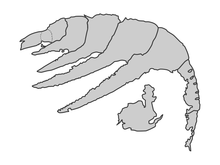
アノマロカリス類は、主にカンブリア紀の堆積層から産出する化石によって知られ、中国[41][13][57][58][4][35][16][17][19][34][22]、北アメリカ(アメリカ[59][60][61][44][20][62][23]、カナダ[49][50][51][63][33][64][15][9]、グリーンランド[65][14])、ヨーロッパ(ポーランド[56]、チェコ[66]、スペイン[15])、オーストラリア[67][68]で発見されている。なお、これらの堆積層の地質年代はいずれも既知最古(カンブリア紀第二期 - 第三期境目、約5億2,100万年前)の真節足動物の化石記録より晩期(最古でもカンブリア紀第三期、約5憶2,000万年前)であるため、節足動物の中で基盤的であるアノマロカリス類とそれに対して派生的である真節足動物の間には、中間的化石記録が欠如していることが示唆される[1]。


長い間、カンブリア紀中期終盤(約5憶100万年前)より晩期の堆積層からアノマロカリス類の化石が発見されなかったため、本群の生息期間はカンブリア紀に限定され、そこで絶滅したと考えられていた。しかし2010年代以降では、オルドビス紀前期のエーギロカシスが発見された[69][5]ことと、デボン紀前期のシンダーハンネス[2]がアノマロカリス類として認められることにより、本群はカンブリア紀を超えて生存していたことが判明し、生息期間の記録が数千万年も延長された。
アノマロカリス類が発見される堆積層は次の通り[16][20][62][22][23]。
- Zawiszany formation(ポーランド):Peytoia infercambriensis[56]
- Niutitang formation(Zunyi Biota、中国、貴州省):Amplectobelua symbrachiata[16]
- Maotianshan Shale(澄江動物群、中国、雲南省):Amplectobelua symbrachiata[13]、Anomalocaris cf. canadensis[31]、Anomalocaris saron[13]、Cambroraster cf. C. falcatus[29]、Cucumericrus decoratus[13]、Laminacaris chimera[34]、Lenisicaris lupata[31]、Lyrarapax trilobus[35]、Lyrarapax unguispinus[4]、Ramskoeldia platyacantha[19]、Ramskoeldia consimilis[19]、Zhenghecaris shankouensis[16]
- Buen formation(シリウス・パセット動物群、グリーンランド):Tamisiocaris borealis[65][14]
- Shuijingtuo Formation(中国、湖北省):Hurdia indet. sp.[70][27][22]
- Shuijingtuo Formation(Qingjiang biota、中国、湖北省):Amplectobelua sp.[71]、Hurdia sp.[71]
- Poleta formation(Indian Springs Biota、アメリカ、ネバダ州):未命名種[72][16]
- Hongjingshao Formation(Malong Fauna、中国、雲南省):Anomalocaris saron[73][74][16]
- Yuxiansi Formations、Jiulaodong Formations(Fandian biota、中国、四川省):YKLP 12377[75]、YKLP 12378[75]
- カンブリア紀第四期(約5億1400万 - 5億900万年前)
- Kinzers Formation(アメリカ、ペンシルベニア州):Amplectobelua aff. symbrachiata[20]、Anomalocaris pennsylvanica[59][20]、Laminacaris? sp.[20]、Tamisiocaris aff. borealis[20]
- Latham Shale(アメリカ、カリフォルニア州):Ramskoeldia consimilis?[76][62]
- Pioche Shale(アメリカ、ネバダ州):Anomalocaris magnabasis[62]、Hurdia sp.[60][62]
- Wulongqing Formation(Guanshan biota、中国、雲南省):Anomalocaris kunmingensis[58]、Paranomalocaris multisegmentalis[58]
- Balang Formation(Balang Biota、中国、湖南省):Anomalocaris sp.[57]、Peytoia cf. nathorsti[57]
- Emu Bay Shale(オーストラリア、カンガルー島):"Anomalocaris" briggsi[67]、Anomalocaris cf. canadensis[68]
- Eager formation(Cranbrook Shale、カナダ、ブリティッシュコロンビア州):Anomalocaris canadensis[59][63][76]
- Pyramid shale(アメリカ、ネバダ州):Anomalocaris magnabasis[62]
- Valdemiedes Formation(Murero biota、スペイン):Caryosyntrips cf. camurus[15]
- カンブリア紀ウリューアン期(約5億900万 - 5億450万年前)
- Mantou Formation(中国、河北省):未命名種[77]
- Mantou Formation(中国、山東省):Cambroraster sp. nov. A[78]
- Kaili Formation(Kaili Biota、中国、貴州省):Amplectobelua sp.[79]、Anomalocaris sp.[79][80]
- Spence Shale(アメリカ、ユタ州):Caryosyntrips camurus[15]、Hurdia victoria[44]、KUMIP 314037[81]
- Mount Cap Formation(カナダ、ノースウエスト準州):Ursulinacaris grallae[32]
- バージェス頁岩(バージェス動物群、カナダ、ブリティッシュコロンビア州):Amplectobelua stephenensis[33]、Anomalocaris canadensis[49]、Cambroraster falcatus[9]、Caryosyntrips camurus[15]、Caryosyntrips serratus[33][15]、Hurdia victoria[51]、Hurdia triangulata[51]、Peytoia nathorsti[50]
- Stanley glacier(バージェス動物群、カナダ、ブリティッシュコロンビア州):Anomalocaris canadensis[64]、Stanleycaris hirpex[64][82]
- Kuonamka Formation(ロシア、シベリア):未命名種[83]
- カンブリア紀ドラミアン期(約5億450万 - 5億50万年前)
- Wheeler Shale(アメリカ、ユタ州):Peytoia nathorsti[44]、Caryosyntrips durus[15]、Caryosyntrips serratus[15]、Stanleycaris sp.[84]、Pahvantia hastata[23]、Buccaspinea cooperi?[23]、Anomalocarididae gen. et sp. nov[85][23]
- Marjum Formation(アメリカ、ユタ州):Peytoia nathorsti[44][23]、Caryosyntrips camurus[23]、Pahvantia hastata[23]、Buccaspinea cooperi[23]
- Jince Formation(チェコ、ボヘミア):Hurdia hospes[66]
- Zhangxia Formation(中国、山東省):Cordaticaris striatus[22]
- カンブリア紀ガズハンジアン期(約5億50万 - 4億9700万年前)
- カンブリア紀ジャンシャニアン期(約4億9400万 - 4億8950万年前)
- Klonówka Shale(ポーランド):UWIPG B/III/1[86]
- Dol-Cyn-Afon Formation(Afon Gam Biota、イギリス、ウェールズ):NMW 2012.36G.90[87]
- Fezouata Formation(Fezouata biota、モロッコ):Aegirocassis benmoulai[5]、フルディア科未命名種[27][69]
- デボン紀前期(約4億800万 - 4億年前)
分類
系統関係
| |||||||||||||||||||||||||||||||||||||||||||||
| 脱皮動物におけるアノマロカリス類の系統位置[5][14][40]。 †:絶滅群 *:Dinocarididaに分類される群 |
アノマロカリス類は、オパビニア、パンブデルリオンやケリグマケラなどと共に、節足動物が葉足動物から一歩ずつ分化する過程に当たる、その系統発生の様子を推定する重要な動物群として注目される[11][12][1]。これらの動物群はいずれも一連の鰭状の付属肢と特殊化した前部付属肢という共有形質が見られ、Dinocaridida[7]というステムグループ節足動物(節足動物の初期系統)の1群としてまとめられる。一見では節足動物に類似しないが、いずれも基盤的な真節足動物らしい消化腺をもち[43]、アノマロカリス類に至っては、関節肢(前部付属肢)と複眼など節足動物との重要な共有形質も出揃っている。アノマロカリス類の背腹2対の鰭や、パンブデルリオンなどの同時に葉足と鰭を持った体制も、節足動物の二叉型付属肢の起源を示唆する形質と見なされる[5]。アノマロカリス類の頭部における背側の甲皮も、フキシャンフィア類やオダライアなどの基盤的な真節足動物の頭部における小さな甲皮と同様に複眼と前大脳性(先節由来)であるため、相同性が挙げられる[28]。
これらの動物は、節足動物のステムグループに属する基盤的な節足動物と考えられ、そのうちアノマロカリス類とオパビニアが真節足動物に最も近縁であることが広く認められる[14][4][88][5][89][11][12][10][1]。
他にもMegacheira類に類縁と考え、お互いの大付属肢/前部付属肢を相同器官と見なし、共に鋏角類のステムグループに属する[90]、もしくは放射状の歯に基づいて、汎節足動物以外の脱皮動物(環神経動物 Cycloneuralia)に類縁する[13]などの異説はかつてあったが、いずれも後に多くの研究結果に否定的とされる[5][4]。前者はアノマロカリス類の他の真節足動物的でない祖先形質で否定できる加えて、互いの大付属肢/前部付属肢も神経解剖学的証拠によって別の体節に由来の相似器官であると示唆される[4]。後者の基準となった放射状の歯は、あくまでも脱皮動物の共有原始形質にすぎず[39]、はしご形神経系の発見も、アノマロカリス類と環神経動物の類縁関係を否定し、汎節足動物であることを示唆する強力な証拠となる[4]。また、シンダーハンネスのいくつかの真節足動物的とされる形質に基づいて、アノマロカリス類を真節足動物に至る側系統群と見なす見解はかつてあった[2]が、再検討によりその形質は曖昧で真節足動物らしきぬとされ、この説も否定的とされるようになった[11](該当記事を参照)。
近縁
アノマロカリス類に近縁の古生物として、上述のオパビニア(Opabinia)、パンブデルリオン (Pambdelurion)とケリグマケラ (Kerygmachela)が挙げられる。いずれもアノマロカリス類と同様に Dinocaridida に属とされ、一連の鰭と特殊化した前部付属肢を持ち、便宜上に「Gilled lobopodians」(鰓のある葉足動物)とも呼ばれた動物群である[5][11]。アノマロカリス類に似通う特徴は他にもいくつか見られ、例えばオパビニアの特殊化した尾鰭にあること・「setal blades」をもつこと・眼が眼柄にあることが本群と共通し[11]、パンブデルリオンは発達した放射状の歯をもち[38]、ケリグマケラは複眼のように多数のレンズからなる眼がある[42]。
これらの動物のアノマロカリス類との主な相違点は、胴部の前端数節が「首」に特化しない[9]、前部付属肢は左右開閉で関節肢化しない、アノマロカリス類とは逆方向に畳んだ鰭、鰓らしき櫛状構造「setal blades」は鰭の表面に張り付く、腹側には脚(葉足)がある、などの特徴が挙げられる[5][11]。これらの動物、特にパンブデルリオンとケリグマケラは葉足動物の共有原始形質を色濃く備えており、アノマロカリス類より基盤的な系統から派生した群であると見なされる[5][11][12][1]。
疑問視される種
-
カリョシントリプスの前部付属肢は左右開閉の構造をもつ
-
ククメリクルスの鰭と脚
-
嚢頭類の甲皮の片割れとして復元されたZhenghecaris
カリョシントリプス(Caryosyntrips)とククメリクルス(Cucumericrus)は、通常ではアノマロカリス類と見なされる[33][5][15][91]。しかしカリョシントリプスの前部付属肢は、左右開閉の構造をもつなどアノマロカリス類との相違点が見られており[92]、それ以外の部位も未だに発見されていない。ククメリクルスの前部付属肢は未だに発見できず、鰭の下面には脚を具えており、しかも葉足と関節肢の両方に似通う中間的形態がみられる[93]。全身化石が出揃っていないこれらの古生物はアノマロカリス類として記載されるものの、アノマロカリス類としての形質がしばしば疑問視される。シンダーハンネス(Schinderhannes)は最初では真節足動物様の特徴(背板など)をもつとされ、これによりアノマロカリス類から区別された[2]が、この解釈は後に否定的に評価され[11]、アノマロカリス類であることも多くの系統解析に支持される[14][4][5][10][9](該当記事を参照)。Zhenghecaris は左右相称のドーム状の外骨格のみによって知られ、原記述では嚢頭類(Thylacocephala)の甲皮と解釈されたが、カンブロラスターに類似するアノマロカリス類の甲皮である可能性がのちに取り上げられる[16][9]。
下位分類
| ||||||||||||||||||||||||||||||||||||||||||||||||||||||||||||||||||||||||||||||||||||
| Aubril et al. (2018) に基づいたアノマロカリス類の系統関係[10]。未命名種は省略される。 |
疑問視されるものをも含め、アノマロカリス類は以下の属が知られている。
- アノマロカリス Anomalocaris [49][53]
- ペイトイア(ペユトイア) Peytoia [50](=ラガニア Laggania [50][37]、Cassubia [94][56])
- フルディア Hurdia [51][40]
- アンプレクトベルア(アムプレクトベルア) Amplectobelua [13]
- ? ククメリクルス Cucumericrus[13]
- シンダーハンネス Schinderhannes [2][14]
- カリョシントリプス Caryosyntrips [33]
- スタンレイカリス Stanleycaris [64][82]
- タミシオカリス Tamisiocaris [65][14]
- パラノマロカリス Paranomalocaris [58]
- ライララパクス Lyrarapax [4]
- エーギロカシス Aegirocassis [5]
- Ramskoeldia [19]
- ラミナカリス[8] Laminacaris [34]
- Pahvantia [52][10]
- Ursulinacaris [32]
- カンブロラスター[8] Cambroraster [9]
- ? Zhenghecaris [95][9]
- Cordaticaris [22]
- Buccaspinea [23]
- Lenisicaris [31]
かつて、全てのアノマロカリス類はアノマロカリス科(Anomalocarididae)に分類された。新たな分類体系が Vinther et al., 2014 に創設されて以降、アノマロカリス類は放射歯目(ラディオドンタ目 Radiodonta)に当たる群とされるようになり、そのうち多くの種類がアンプレクトベルア科(Amplectobeluidae)・タミシオカリス科(Tamisiocarididae、=Cetiocaridae)・フルディア科(Hurdiidae)という新たに創設される3つの科に再分類された[14]。カリョシントリプスをアノマロカリス類に含まれる場合、本属はどの科にも属さず、残り全てのアノマロカリス類(アノマロカリス亜目 Anomalocarida)の姉妹群として基盤的なアノマロカリス類とされる[5][14][10]。
アノマロカリス類の内部系統関係について、フルディア科の単系統性は広く認められるが、アノマロカリス科とアンプレクトベルア科の内部構成は不確実である[34]。特にアノマロカリス科のアノマロカリス属は往々にして非単系統群であるとされ、分岐学的にはタイプ種であるアノマロカリス・カナデンシスよりも、別のアノマロカリス類(主にアンプレクトベルア科)に近い系統に位置付けされる種類がほとんどである[14][4][10]。ライララパクスは従来ではアンプレクトベルア科に分類されるが、歯と首の構造の相違点によって本科としての形質がしばしば疑問視される[19][34]。
2020年現在、約30種のアノマロカリス類が正式に記載されており、4つの科の中でフルディア科は最も多様で、十数種を含んでいる[22]。
- 放射歯目(ラディオドンタ目)Radiodonta [7]
- ? ククメリクルス属 Cucumericrus [13]
- Cucumericrus decoratus [13]
- カリョシントリプス属 Caryosyntrips [33]
- アノマロカリス亜目 Anomalocarida [14]
- パラノマロカリス属 Paranomalocaris [58](アノマロカリス科に分類される場合がある[5][18])
- Paranomalocaris multisegmentalis [58]
- ラミナカリス属 Laminacaris [34](アンプレクトベルア科に分類される場合がある[10])
- Laminacaris chimera [34]
- アノマロカリス科 Anomalocarididae [25]
- アノマロカリス属 Anomalocaris [49](一部の種は別系統とされる場合がある[4][14][10][31])
- アノマロカリス・カナデンシス Anomalocaris canadensis [49]
- Anomalocaris pennsylvanica [59](Wu et al. 2021 で Lenisicaris に分類される[31])
- アノマロカリス・サロン Anomalocaris saron [13](アンプレクトベルア科に分類される場合がある[14][10]、別属にする見解がある[31])
- Anomalocaris kunmingensis [58](Amplectobelua kunmingensis として記載される場合がある[14])
- Anomalocaris magnabasis [62](別属にする見解がある[31])
- (属)Lenisicaris [31]
- Lenisicaris lupata [31]
- アノマロカリス属 Anomalocaris [49](一部の種は別系統とされる場合がある[4][14][10][31])
- アンプレクトベルア科 Amplectobeluidae [14]
- タミシオカリス科 Tamisiocarididae [10](=Cetiocaridae [14])
- "アノマロカリス"・ブリッグシ "Anomalocaris" briggsi [67][14]
- タミシオカリス属 Tamisiocaris [65]
- フルディア科 Hurdiidae [14]
- ペイトイア(ペユトイア)属 Peytoia [50](=ラガニア属 Laggania [50][37]、=Cassubia [94][56])
- シンダーハンネス属 Schinderhannes [2]
- フルディア属 Hurdia [51]
- エーギロカシス属 Aegirocassis [5]
- Aegirocassis benmoulai [5]
- スタンレイカリス属 Stanleycaris [64][82]
- (属)Pahvantia [52]
- (属)Ursulinacaris [32]
- Ursulinacaris grallae [32]
- カンブロラスター属 Cambroraster [9]
- カンブロラスター・ファルカトゥス Cambroraster falcatus [9]
- ?(属)Zhenghecaris [95]
- (属)Cordaticaris [22]
- Cordaticaris striatus [22]
- (属)Buccaspinea [23]
- Buccaspinea cooperi [23]
- パラノマロカリス属 Paranomalocaris [58](アノマロカリス科に分類される場合がある[5][18])
- ? ククメリクルス属 Cucumericrus [13]
アノマロカリス類と誤認された古生物
限られた部位の化石によって知られ、それをアノマロカリス類に由来と誤認された別生物は、以下の例が挙げられる。

- パラペイトイア(パラペユトイア)Parapeytoia yunnanensis [13]
- 付属肢と腹板のみによって知られる。1995年に「脚のあるアノマロカリス類」として復元されたが、2010年代以降からMegacheira類の真節足動物と見なされるようになった[40][97][98][3][5][99]。(詳細はパラペイトイアを参照)
- 一連の歯からなる口器のみによって知られる。1994年に巨大なアノマロカリス類の oral cone と考えられ[41]、2008年に鰓曳動物の口器とされると同時に新属新種として記載された[100]が、2016年にパンブデルリオンらしい動物の口器と見なされるようになった[38]。
- Tauricornicaris latizonae と Tauricornicaris oxygonae [16]
脚注
- ^ a b c d e f Daley, Allison; Antcliffe, Jonathan; Drage, Harriet; Pates, Stephen (2018-05-21). “Early fossil record of Euarthropoda and the Cambrian Explosion”. Proceedings of the National Academy of Sciences 115: 201719962. doi:10.1073/pnas.1719962115.
- ^ a b c d e f g h i j k Kühl, G.; Briggs, D. E. G.; Rust, J. (Feb 2009). “A Great-Appendage Arthropod with a Radial Mouth from the Lower Devonian Hunsrück Slate, Germany”. Science 323 (5915): 771–3. doi:10.1126/science.1166586. ISSN 0036-8075. PMID 19197061.
- ^ a b c d e f g h i j k l m n o p C., Daley, Allison; D., Edgecombe, Gregory (2014). “Morphology of Anomalocaris canadensis from the Burgess Shale” (英語). Journal of Paleontology 88 (01). ISSN 0022-3360.
- ^ a b c d e f g h i j k l m n o p q r s t u v w Peiyun Cong; Xiaoya Ma; Xianguang Hou; Gregory D. Edgecombe; Nicholas J. Strausfeld (2014). “Brain structure resolves the segmental affinity of anomalocaridid appendages”. Nature 513 (7519): 538–42. doi:10.1038/nature13486. PMID 25043032.
- ^ a b c d e f g h i j k l m n o p q r s t u v w x y z aa ab ac ad ae af ag ah ai aj Van Roy, Peter; Daley, Allison C.; Briggs, Derek E. G. (2015). “Anomalocaridid trunk limb homology revealed by a giant filter-feeder with paired flaps”. Nature 522 (7554): 77–80. doi:10.1038/nature14256. ISSN 0028-0836. PMID 25762145.
- ^ a b c d e f g h i Cong, Peiyun; Daley, Allison C.; Edgecombe, Gregory D.; Hou, Xianguang (2017-08-30). “The functional head of the Cambrian radiodontan (stem-group Euarthropoda) Amplectobelua symbrachiata” (英語). BMC Evolutionary Biology 17 (1). doi:10.1186/s12862-017-1049-1. ISSN 1471-2148. PMC PMC5577670. PMID 28854872.
- ^ a b c d e f g h i j Collins, Desmond (1996/03). “The “evolution” of Anomalocaris and its classification in the arthropod class Dinocarida (nov.) and order Radiodonta (nov.)” (英語). Journal of Paleontology 70 (2): 280–293. doi:10.1017/S0022336000023362. ISSN 0022-3360.
- ^ a b c d e 土屋, 健 (サイエンスライター) (2020-2-12). アノマロカリス解体新書. 田中 源吾 (監修), かわさき しゅんいち (イラスト). 東京: ブックマン社. ISBN 978-4-89308-928-1. OCLC 1141813539
- ^ a b c d e f g h i j k l m n o p q r s t u v w x y z aa ab ac ad ae af ag Moysiuk J.; Caron J.-B. (2019-08-14). “A new hurdiid radiodont from the Burgess Shale evinces the exploitation of Cambrian infaunal food sources”. Proceedings of the Royal Society B: Biological Sciences 286 (1908): 20191079. doi:10.1098/rspb.2019.1079.
- ^ a b c d e f g h i j k l m n o p q r s t Lerosey-Aubril, Rudy; Pates, Stephen (2018-09-14). “New suspension-feeding radiodont suggests evolution of microplanktivory in Cambrian macronekton” (英語). Nature Communications 9 (1). doi:10.1038/s41467-018-06229-7. ISSN 2041-1723.
- ^ a b c d e f g h i j k l m n Ortega-Hernández, Javier (2016-02). “Making sense of ‘lower’ and ‘upper’ stem-group Euarthropoda, with comments on the strict use of the name Arthropoda von Siebold, 1848: Upper and lower stem-Euarthropoda” (英語). Biological Reviews 91 (1): 255–273. doi:10.1111/brv.12168.
- ^ a b c d e f g Ortega-Hernández, Javier; Janssen, Ralf; Budd, Graham E. (2017-05-01). “Origin and evolution of the panarthropod head – A palaeobiological and developmental perspective” (英語). Arthropod Structure & Development 46 (3): 354–379. doi:10.1016/j.asd.2016.10.011. ISSN 1467-8039.
- ^ a b c d e f g h i j k l m n o p Xian‐Guang, Hou; Bergström, Jan; Ahlberg, Per (1995-09-01). “Anomalocaris and Other Large Animals in the Lower Cambrian Chengjiang Fauna of Southwest China”. GFF 117: 163–183. doi:10.1080/11035899509546213.
- ^ a b c d e f g h i j k l m n o p q r s t u v w x y z Jakob Vinther, Martin Stein, Nicholas R. Longrich & David A. T. Harper (2014). “A suspension-feeding anomalocarid from the Early Cambrian”. Nature 507: 496–499. doi:10.1038/nature13010. PMID 24670770.
- ^ a b c d e f g h i j k l m n o Pates, Stephen; Daley, Allison C. (2017-08). “Caryosyntrips: a radiodontan from the Cambrian of Spain, USA and Canada” (英語). Papers in Palaeontology 3 (3): 461–470. doi:10.1002/spp2.1084. ISSN 2056-2802.
- ^ a b c d e f g h i j k l m n Zeng, Han; Zhao, Fangchen; Yin, Zongjun; Zhu, Maoyan (2017-01-04). “Morphology of diverse radiodontan head sclerites from the early Cambrian Chengjiang Lagerstätte, south-west China”. Journal of Systematic Palaeontology 16: 1. doi:10.1080/14772019.2016.1263685.
- ^ a b c d Zeng, Han; Zhao, Fangchen; Yin, Zongjun; Zhu, Maoyan (2018-01). “A new radiodontan oral cone with a unique combination of anatomical features from the early Cambrian Guanshan Lagerstätte, eastern Yunnan, South China” (英語). Journal of Paleontology 92 (1): 40–48. doi:10.1017/jpa.2017.77. ISSN 0022-3360.
- ^ a b c d e Liu, Jianni; Lerosey-Aubril, Rudy; Steiner, Michael; Dunlop, Jason A.; Shu, Degan; Paterson, John R. (2018). “Origin of raptorial feeding in juvenile euarthropods revealed by a Cambrian radiodontan” (英語). National Science Review. doi:10.1093/nsr/nwy057.
- ^ a b c d e f g h i j k l m Cong, Pei-Yun; Edgecombe, Gregory D.; Daley, Allison C.; Guo, Jin; Pates, Stephen; Hou, Xian-Guang (2018-06-23). “New radiodonts with gnathobase-like structures from the Cambrian Chengjiang biota and implications for the systematics of Radiodonta” (英語). Papers in Palaeontology. doi:10.1002/spp2.1219. ISSN 2056-2802.
- ^ a b c d e f g h Pates, Stephen; Daley, Allison C. (2019/07). “The Kinzers Formation (Pennsylvania, USA): the most diverse assemblage of Cambrian Stage 4 radiodonts” (英語). Geological Magazine 156 (7): 1233–1246. doi:10.1017/S0016756818000547. ISSN 0016-7568.
- ^ a b c Paterson, John R.; Edgecombe, Gregory D.; García-Bellido, Diego C. (2020-12-01). “Disparate compound eyes of Cambrian radiodonts reveal their developmental growth mode and diverse visual ecology” (英語). Science Advances 6 (49): eabc6721. doi:10.1126/sciadv.abc6721. ISSN 2375-2548. PMID 33268353.
- ^ a b c d e f g h i j k Sun, Zhixin; Zeng, Han; Zhao, Fangchen (2020-08-01). “A new middle Cambrian radiodont from North China: Implications for morphological disparity and spatial distribution of hurdiids” (英語). Palaeogeography, Palaeoclimatology, Palaeoecology: 109947. doi:10.1016/j.palaeo.2020.109947. ISSN 0031-0182.
- ^ a b c d e f g h i j k l m n o p q Pates, Stephen; Lerosey-Aubril, Rudy; Daley, Allison C.; Kier, Carlo; Bonino, Enrico; Ortega-Hernández, Javier (2021-01-19). “The diverse radiodont fauna from the Marjum Formation of Utah, USA (Cambrian: Drumian)” (英語). PeerJ 9: e10509. doi:10.7717/peerj.10509. ISSN 2167-8359.
- ^ 大むかしの生きもの. 群馬県立自然史博物館.. Tōkyō: 講談社. (2020). ISBN 978-4-06-518985-6. OCLC 1163637303
- ^ a b RAYMOND, P. E. 1935. Leanchoilia and other mid-Cambrian Arthropoda. Bulletin of the Museum of Comparative Zoology, Harvard University, 76: 205–230.
- ^ “脳構造から明らかになるアノマロカリス類の付属肢の体節との関連性 | Nature | Nature Research”. www.natureasia.com. 2018年9月17日閲覧。
- ^ a b c d e f g h i j k l Daley, Allison; Budd, Graham; Caron, Jean-Bernard (2013-10-01). “The morphology and systematics of the anomalocarid Hurdia from the Middle Cambrian of British Columbia and Utah”. Journal of Systematic Palaeontology 11. doi:10.1080/14772019.2012.732723.
- ^ a b c “Homology of Head Sclerites in Burgess Shale Euarthropods” (英語). Current Biology 25 (12): 1625–1631. (2015-06-15). doi:10.1016/j.cub.2015.04.034. ISSN 0960-9822.
- ^ a b c Liu, Yu; Lerosey-Aubril, Rudy; Audo, Denis; Zhai, Dayou; Mai, Huijuan; Ortega-Hernández, Javier (2020-07). “Occurrence of the eudemersal radiodont Cambroraster in the early Cambrian Chengjiang Lagerstätte and the diversity of hurdiid ecomorphotypes” (英語). Geological Magazine 157 (7): 1200–1206. doi:10.1017/S0016756820000187. ISSN 0016-7568.
- ^ “カンブリア紀の「優しい巨人」 | Nature ダイジェスト | Nature Research”. www.natureasia.com. 2019年1月19日閲覧。
- ^ a b c d e f g h i j k l Wu, Yu; Ma, Jiaxin; Lin, Weiliang; Sun, Ao; Zhang, Xingliang; Fu, Dongjing (2021-03-03). “New anomalocaridids (Panarthropoda: Radiodonta) from the lower Cambrian Chengjiang Lagerstätte: Biostratigraphic and paleobiogeographic implications” (英語). Palaeogeography, Palaeoclimatology, Palaeoecology: 110333. doi:10.1016/j.palaeo.2021.110333. ISSN 0031-0182.
- ^ a b c d e Pates, Stephen; Daley, Allison C.; Butterfield, Nicholas J. (2019-12). “First report of paired ventral endites in a hurdiid radiodont” (英語). Zoological Letters 5 (1). doi:10.1186/s40851-019-0132-4. ISSN 2056-306X. PMC PMC6560863. PMID 31210962.
- ^ a b c d e f g h i j k DALEY, ALLISON C.; BUDD, GRAHAM E. (2010-07-19). “New anomalocaridid appendages from the Burgess Shale, Canada” (英語). Palaeontology 53 (4): 721–738. doi:10.1111/j.1475-4983.2010.00955.x. ISSN 0031-0239.
- ^ a b c d e f g h i j k Guo, Jin; Pates, Stephen; Cong, Peiyun; Daley, Allison; Edgecombe, Gregory; Chen, Taimin; Hou, Xianguang (2018-08-17). “A new radiodont (stem Euarthropoda) frontal appendage with a mosaic of characters from the Cambrian (Series 2 Stage 3) Chengjiang biota”. Papers in Palaeontology. doi:10.1002/spp2.1231.
- ^ a b c d e f Cong, Peiyun; Daley, Allison C.; Edgecombe, Gregory D.; Hou, Xianguang; Chen, Ailin (2016-07). “Morphology of the radiodontan Lyrarapax from the early Cambrian Chengjiang biota” (英語). Journal of Paleontology 90 (4): 663–671. doi:10.1017/jpa.2016.67. ISSN 0022-3360.
- ^ Zeng, Han; Zhao, Fangchen; Niu, Kecheng; Zhu, Maoyan; Huang, Diying (2020-12). “An early Cambrian euarthropod with radiodont-like raptorial appendages” (英語). Nature 588 (7836): 101–105. doi:10.1038/s41586-020-2883-7. ISSN 1476-4687.
- ^ a b c d e f g h i Daley, Allison; Bergström, Jan (2012-04-05). “The oral cone of Anomalocaris is not a classic ‘‘peytoia’’”. Die Naturwissenschaften 99: 501–4. doi:10.1007/s00114-012-0910-8.
- ^ a b c Vinther, Jakob; Porras, Luis; Young, Fletcher; Budd, Graham; Edgecombe, Gregory (2016-09-01). “The mouth apparatus of the Cambrian gilled lobopodian Pambdelurion whittingtoni”. Palaeontology. doi:10.1111/pala.12256.
- ^ a b c Smith, Martin; Caron, Jean-Bernard (2015-07-02). “Hallucigenia’s head and the pharyngeal armature of early ecdysozoans”. Nature 523: 75–78. doi:10.1038/nature14573.
- ^ a b c d e f g h i j Daley, Allison C.; Budd, Graham E.; Caron, Jean-Bernard; Edgecombe, Gregory D.; Collins, Desmond (2009-03-20). “The Burgess Shale Anomalocaridid Hurdia and Its Significance for Early Euarthropod Evolution” (英語). Science 323 (5921): 1597–1600. doi:10.1126/science.1169514. ISSN 0036-8075. PMID 19299617.
- ^ a b c Chen, Jun-yuan; Ramsköld, Lars; Zhou, Gui-qing (1994-05-27). “Evidence for Monophyly and Arthropod Affinity of Cambrian Giant Predators” (英語). Science 264 (5163): 1304–1308. doi:10.1126/science.264.5163.1304. ISSN 0036-8075. PMID 17780848.
- ^ a b Park, Tae-Yoon S.; Kihm, Ji-Hoon; Woo, Jusun; Park, Changkun; Lee, Won Young; Smith, M. Paul; Harper, David A. T.; Young, Fletcher et al. (2018-03-09). “Brain and eyes of Kerygmachela reveal protocerebral ancestry of the panarthropod head” (英語). Nature Communications 9 (1). doi:10.1038/s41467-018-03464-w. ISSN 2041-1723.
- ^ a b c Vannier, Jean; Liu, Jianni; Lerosey-Aubril, Rudy; Vinther, Jakob; Daley, Allison C. (2014-05-02). “Sophisticated digestive systems in early arthropods” (英語). Nature Communications 5 (1). doi:10.1038/ncomms4641. ISSN 2041-1723.
- ^ a b c d e Pates, Stephen; Daley, Allison C.; Lieberman, Bruce S. (2018/01). “Hurdiid radiodontans from the middle Cambrian (Series 3) of Utah” (英語). Journal of Paleontology 92 (1): 99–113. doi:10.1017/jpa.2017.11. ISSN 0022-3360.
- ^ Usami, Yoshiyuki (2006-01-07). “Theoretical study on the body form and swimming pattern of Anomalocaris based on hydrodynamic simulation”. Journal of Theoretical Biology 238 (1): 11–17. doi:10.1016/j.jtbi.2005.05.008. ISSN 0022-5193. PMID 16002096.
- ^ Sheppard, K. A.; Rival, D. E.; Caron, J.-B.. “On the Hydrodynamics of Anomalocaris Tail Fins” (英語). Integrative and Comparative Biology. doi:10.1093/icb/icy014.
- ^ a b c De Vivo, Giacinto; Lautenschlager, Stephan; Vinther, Jakob (2016-12-16). Reconstructing anomalocaridid feeding appendage dexterity sheds light on radiodontan ecology.
- ^ Paterson, John R.; García-Bellido, Diego C.; Lee, Michael S. Y.; Brock, Glenn A.; Jago, James B.; Edgecombe, Gregory D. (2011-12). “Acute vision in the giant Cambrian predator Anomalocaris and the origin of compound eyes” (英語). Nature 480 (7376): 237–240. doi:10.1038/nature10689. ISSN 0028-0836.
- ^ a b c d e f g h WHITEAVES, J. F. 1892. Description of a new genus and species of phyllocarid Crustacea from the Middle Cambrian of Mount Stephen, B.C. Canadian Record of Science, 5: 205-208.
- ^ a b c d e f g h i j k WALCOTT, C. D. 1911. Middle Cambrian holothurians and medusae. Cambrian geoogy and paleontology II. Smithsonian Miscellaneous Collections, 57: 41-68.
- ^ a b c d e f g h i WALCOTT, C. D. 1912. Middle Cambrian Branchiopoda, Malacostraca, Trilobita and Merostomata. Smithsonian Miscellaneous Collections, 57: 145-228.
- ^ a b c d Robison, R. A. & Richards, B. C. (1981). Larger bivalve arthropods from the middle Cambrian of Utah. Univ. Kansas Paleontol. Contr. 106, 1–28.
- ^ a b c d Whittington, Harry Blackmore; Briggs, Derek Ernest Gilmor (1985-05-14). “The largest Cambrian animal, Anomalocaris, Burgess Shale, British-Columbia” (英語). Phil. Trans. R. Soc. Lond. B 309 (1141): 569–609. doi:10.1098/rstb.1985.0096. ISSN 0080-4622.
- ^ Jay,, Gould, Stephen. Wonderful life : the Burgess Shale and the nature of history (First edition ed.). New York. ISBN 0393027058. OCLC 18983518
- ^ ROLFE, W. D. I. 1962. Two new arthropod carapaces from the Burgess Shale (Middle Cambrian) of Canada. Breviora Museum of Comparative Zoology, 60: 1-9.
- ^ a b c d e f Daley, Allison C.; Legg, David A. (2015/09). “A morphological and taxonomic appraisal of the oldest anomalocaridid from the Lower Cambrian of Poland” (英語). Geological Magazine 152 (5): 949–955. doi:10.1017/S0016756815000412. ISSN 0016-7568.
- ^ a b c Liu, Qing (2013-09-01). “The first discovery of anomalocaridid appendages from the Balang Formation (Cambrian Series 2) in Hunan, China”. Alcheringa: An Australasian Journal of Palaeontology 37 (3): 338–343. doi:10.1080/03115518.2013.753767. ISSN 0311-5518.
- ^ a b c d e f g Yuanyuan, Wang; Huang, Diying; Hu, Shixue (2013-11-01). “New anomalocardid frontal appendages from the Guanshan biota, eastern Yunnan”. Chinese Science Bulletin 58. doi:10.1007/s11434-013-5908-x.
- ^ a b c d Resser, Charles E. (1929). “New Lower and Middle Cambrian Crustacea” (英語). Proceedings of the United States National Museum 76 (2806): 1–18. doi:10.5479/si.00963801.76-2806.1.
- ^ a b Lieberman, Bruce S. (2003-07). “A new soft-bodied fauna: The Pioche Formation of Nevada” (英語). Journal of Paleontology 77 (4): 674–690. doi:10.1017/S0022336000044413. ISSN 0022-3360.
- ^ a b c Lerosey-Aubril, R.; Hegna, T.A.; Babcock, L.E.; Bonino, E.; Kier, C. (2014-05-19). “Arthropod appendages from the Weeks Formation Konservat-Lagerstätte: new occurrences of anomalocaridids in the Cambrian of Utah, USA”. Bulletin of Geosciences: 269–282. doi:10.3140/bull.geosci.1442. ISSN 1802-8225.
- ^ a b c d e f g Pates, Stephen; Daley, Allison C.; Edgecombe, Gregory D.; Cong, Peiyun; Lieberman, Bruce S. (2019). “Systematics, preservation and biogeography of radiodonts from the southern Great Basin, USA, during the upper Dyeran (Cambrian Series 2, Stage 4)” (英語). Papers in Palaeontology n/a (n/a). doi:10.1002/spp2.1277. ISSN 2056-2802.
- ^ a b BRIGGS, D. E. G. 1979. Anomalocaris, the largest known Cambrian arthropod. Palaeontology, 22, 3, 631–664.
- ^ a b c d e f Caron, J. -B.; Gaines, R. R.; Mangano, M. G.; Streng, M.; Daley, A. C. (2010). “A new Burgess Shale-type assemblage from the "thin" Stephen Formation of the southern Canadian Rockies”. Geology 38 (9): 811. doi:10.1130/G31080.1.
- ^ a b c d e Daley, Allison C.; Peel, John S. (2010). “A Possible Anomalocaridid from the Cambrian Sirius Passet Lagerstätte, North Greenland” (英語). Journal of Paleontology 84 (2): 352–355. ISSN 0022-3360.
- ^ a b CHLUPÁČ, I. AND V. KORDULE. 2002. Arthropods of Burgess Shale type from the Middle Cambrian of Bohemia (Czech Republic). Bulletin of the Czech Geological Survey, 77: 167-182.
- ^ a b c Nedin, Christopher. (1995). The Emu Bay Shale, a Lower Cambrian fossil Lagerst€atten, Kangaroo Island, South Australia. Memoirs of the Association of Australasian Palaeontologists, 18, 31–40.
- ^ a b Daley, Allison C.; Paterson, John R.; Edgecombe, Gregory D.; García‐Bellido, Diego C.; Jago, James B. (2013). “New anatomical information on Anomalocaris from the Cambrian Emu Bay Shale of South Australia and a reassessment of its inferred predatory habits” (英語). Palaeontology 56 (5): 971–990. doi:10.1111/pala.12029. ISSN 1475-4983.
- ^ a b Van Roy, Peter; Briggs, Derek E. G. (2011-05). “A giant Ordovician anomalocaridid” (英語). Nature 473 (7348): 510–513. doi:10.1038/nature09920. ISSN 0028-0836.
- ^ CU I, Z. L. and HUO, S. C. 1990. New discoveries of Lower Cambrian crustacean fossils from Western Hubei. Acta Palaeontologica Sinica, 29, 321–330.
- ^ a b Fu, Dongjing; Tong, Guanghui; Dai, Tao; Liu, Wei; Yang, Yuning; Zhang, Yuan; Cui, Linhao; Li, Luoyang et al. (2019-03-22). “The Qingjiang biota—A Burgess Shale–type fossil Lagerstätte from the early Cambrian of South China” (英語). Science 363 (6433): 1338–1342. doi:10.1126/science.aau8800. ISSN 0036-8075. PMID 30898931.
- ^ English, A.M. & Babcock, L.E. 2010. Census of the Indian Springs Lagerstätte, Poleta Formation (Cambrian), western Nevada, USA. Palaeogeography, Palaeoclimatology, Palaeoecology, 295(1–2): 236-244.
- ^ Zhang, Xingliang; Shu, Degan; Li, Yong; Han, Jian (2001-03-01). “New sites of Chengjiang fossils: crucial windows on the Cambrian explosion” (英語). Journal of the Geological Society 158 (2): 211–218. doi:10.1144/jgs.158.2.211. ISSN 0016-7649.
- ^ Early Cambrian Malong Fauna and Guanshan Fauna from Eastern Yunnan,China. Luo Huilin,Li Youg,Hu Shixue,Fu Xiaoping,Hou Shuguang,Liu Xingyao,Chen Liangzhong,Li Fengjun,Pang Jiyuan and Liu Qi. Kunming: Yunnan Science and Techonology Press. (2008). pp. 134 pp. ISBN 978-7-5416-2957-0. OCLC 489302441
- ^ a b “A new early Cambrian Konservat-Lagerstätte expands the occurrence of Burgess Shale-type deposits on the Yangtze Platform” (英語). Earth-Science Reviews 211: 103409. (2020-12-01). doi:10.1016/j.earscirev.2020.103409. ISSN 0012-8252.
- ^ a b Briggs, Derek E. G.; Mount, Jack D. (1982). “The Occurrence of the Giant Arthropod Anomalocaris in the Lower Cambrian of Southern California, and the Overall Distribution of the Genus”. Journal of Paleontology 56 (5): 1112–1118. ISSN 0022-3360.
- ^ Huang, D., Wang, Y., Gao, J., & Wang, Y. (2012). A new anomalocaridid frontal appendage from the Middle Cambrian Mantou Formation of the Tangshan Area. Acta Palaeontologica Sinica, 51, 411-415. ISSN 0001-6616.
- ^ Sun, Zhixin; Zeng, Han; Zhao, Fangchen (2020/09). “Occurrence of the hurdiid radiodont Cambroraster in the middle Cambrian (Wuliuan) Mantou Formation of North China” (英語). Journal of Paleontology 94 (5): 881–886. doi:10.1017/jpa.2020.21. ISSN 0022-3360.
- ^ a b Yuanlong, Zhao; Maoyan, Z. H. U.; Babcock, Loren E.; Jinliang, Yuan; Parsley, Ronald L.; Jin, Peng; Xinglian, Yang; Yue, Wang (2005). “Kaili Biota: A Taphonomic Window on Diversification of Metazoans from the Basal Middle Cambrian: Guizhou, China” (英語). Acta Geologica Sinica - English Edition 79 (6): 751–765. doi:10.1111/j.1755-6724.2005.tb00928.x. ISSN 1755-6724.
- ^ The Kaili Biota: marine organisms from 508 millon years ago. Zhao, Y.-L., Zhu, M.-Y., Babcock, L.E., Yuan, J.-L. & Peng, J. (1 ed.). Guiyang: Guizhou Science and Technology Press. (2011). pp. 251 pp.. ISBN 978-7-80662-898-0. OCLC 779181763
- ^ Briggs, Derek E. G.; Lieberman, Bruce S.; Hendricks, Jonathan R.; Halgedahl, Susan L.; Jarrard, Richard D. (2008-03). “Middle Cambrian arthropods from Utah” (英語). Journal of Paleontology 82 (2): 238–254. doi:10.1666/06-086.1. ISSN 0022-3360.
- ^ a b c d Pates, Stephen; Daley, Allison C.; Ortega-Hernández, Javier (2018-03-03). Reply to Comment on "Aysheaia prolata from the Utah Wheeler Formation (Drumian, Cambrian) is a frontal appendage of the radiodontan Stanleycaris" with the formal description of Stanleycaris. doi:10.31233/osf.io/ek4z6.
- ^ Ponomarenko, A. G. (2010-09-01). “First record of dinocarida from Russia” (英語). Paleontological Journal 44 (5): 503–504. doi:10.1134/S0031030110050047. ISSN 1555-6174.
- ^ Pates, Stephen; Daley, Allison; Ortega-Hernández, Javier (2017). “Aysheaia prolata from the Wheeler Formation (Cambrian, Drumian) is a frontal appendage of the radiodontan Stanleycaris”. Acta Palaeontologica Polonica 62. doi:10.4202/app.00361.2017.
- ^ Halgedahl, S. L.; Jarrard, R. D.; Brett, C. E.; Allison, P. A. (2009-06-01). “Geophysical and geological signatures of relative sea level change in the upper Wheeler Formation, Drum Mountains, West-Central Utah: A perspective into exceptional preservation of fossils” (英語). Palaeogeography, Palaeoclimatology, Palaeoecology 277 (1): 34–56. doi:10.1016/j.palaeo.2009.02.011. ISSN 0031-0182.
- ^ Masiak, M., Zylińska, A., 1994. Burgess Shale-type fossils in Cambrian sandstones of the Holy Cross Mountains. Acta Palaeontologica Polonica 39, 329–340.
- ^ Pates, Stephen; Botting, Joseph P.; McCobb, Lucy M. E.; Muir, Lucy A. (2020-06). “A miniature Ordovician hurdiid from Wales demonstrates the adaptability of Radiodonta” (英語). Royal Society Open Science 7 (6): 200459. doi:10.1098/rsos.200459. ISSN 2054-5703. PMC PMC7353989. PMID 32742697.
- ^ Smith, Martin R.; Ortega-Hernández, Javier (2014-08-17). “Hallucigenia’s onychophoran-like claws and the case for Tactopoda”. Nature 514 (7522): 363–366. doi:10.1038/nature13576. ISSN 0028-0836.
- ^ Briggs, Derek E. G. (2015-04-19). “Extraordinary fossils reveal the nature of Cambrian life: a commentary on Whittington (1975) ‘The enigmatic animal Opabinia regalis, Middle Cambrian, Burgess Shale, British Columbia’” (英語). Phil. Trans. R. Soc. B 370 (1666): 20140313. doi:10.1098/rstb.2014.0313. ISSN 0962-8436. PMID 25750235.
- ^ Haug, Joachim; Waloszek, Dieter; Maas, Andreas; Liu, Yu; Haug, Carolin (2012-03-01). “Functional morphology, ontogeny and evolution of mantis shrimp-like predators in the Cambrian”. Palaeontology 55: 369–399. doi:10.1111/j.1475-4983.2011.01124.x.
- ^ 土屋健『エディアカラ紀・カンブリア紀の生物』(技術評論社 2013)
- ^ “Comment on “Aysheaia prolata from the Utah Wheeler Formation (Drumian, Cambrian) is a frontal appendage of the radiodontan Stanleycaris” by Stephen Pates, Allison C. Daley, and Javier Ortega-Hernández - Acta Palaeontologica Polonica” (英語). www.app.pan.pl. 2018年9月19日閲覧。
- ^ Jan Bergström & Hou Xian-Guang (2003). “Arthropod origins” (PDF). Bulletin of Geosciences 78 (4): 323–334.
- ^ a b c Lendzion, Kazimiera (1977). "Cassubia - a new generic name for Pomerania Lendzion, 1975". Geological Quarterly. 21 (1).
- ^ a b c Vannier, J., Huang, D.-Y., Charbonnier, S., Wang, X.-Q. & Chen, J.-Y. 2006. The Early Cambrian origin of thylacocephalan arthropods. Acta Palaeontologica Polonica, 51, 201–214.
- ^ Lendzion, Kazimiera (1975). "Fauna of the Mobergella zone in the Polish Lower Cambrian". 19 (2): 237–242.
- ^ STEIN, MARTIN (2010-02-26). “A new arthropod from the Early Cambrian of North Greenland, with a ‘great appendage’-like antennula” (英語). Zoological Journal of the Linnean Society 158 (3): 477–500. doi:10.1111/j.1096-3642.2009.00562.x. ISSN 0024-4082.
- ^ Legg, David (2013-05-01). “Multi-Segmented Arthropods from the Middle Cambrian of British Columbia (Canada)”. Journal of Paleontology 87: 493–501. doi:10.1666/12-112.1.
- ^ The Cambrian fossils of Chengjiang, China : the flowering of early animal life. Hou, Xianguang. (Second edition ed.). Chichester, West Sussex. ISBN 9781118896310. OCLC 970396735
- ^ a b Xianguang, Hou; Bergström, Jan; Jie, Yang (2006). “Distinguishing anomalocaridids from arthropods and priapulids” (ドイツ語). Geological Journal 41 (3-4): 259–269. doi:10.1002/gj.1050. ISSN 1099-1034.
- ^ “Anomalocaridids and the origin of arthropods: the view from Chengjiang” (英語). ResearchGate. 2019年1月19日閲覧。
参考文献
- Briggs, Derek; Collier, Frederick; Erwin, Douglas. The Fossils of the Burgess Shale. Smithsonian Books, 1995.
- James W. Valentine. On the Origin of Phyla. University Of Chicago Press, 2004.
- Tim Haines & Paul Chambers. The Complete Guide to Prehistoric Life. BBC Books, 2005.
- Conway Morris, Simon. The Crucible of Creation. Oxford University Press, 1998.







